Being rather, er, eclectic, it happens that one of my areas of keenest interest and expertise is the global military naval balance, and naval technologies, part of my larger strategic studies / international relations background. The following reflects decades of study, and is perhaps of limited interest to the general reader, but what the heck, I wrote it, may as well post it.
The piece is illustrated by numerous photos gleaned from the internet. I will gladly remove any of them in response to copyright complaint.

THE UNITED STATES NAVY IN 2022 – CAPABILITIES AND PROSPECTS
There are reasons to be worried about the future of the United States Navy. Readiness is relatively poor, fleet size is beginning to look wholly insufficient, and many current programs seem to be in disarray, or simply to have been misguided from the outset. Those who think and write about such things, and not just the self-styled experts akin to your faithful scribe, are aghast these days. They always have been, of course, but there’s no denying that a lot of what’s now going on would tax the gruntlement of anybody who cares much about the state of Western sea power.
Case in point: for far too many years, the USN, rather than build a proper frigate like every other navy, opted for the Littoral Combat Ship, a toothless, glass-jawed aluminum speedboat that amounts to little more than a very expensive way to put a helicopter and a 57mm gun to sea (oh, very well, half of them have steel hulls, not aluminum). There were to have been at least 30 of these things, built to two different designs, out sailing in harm’s way, providing presence, but little to frighten anyone better equipped than the average Somali pirate. Only recently has the Navy awoken to the folly of this program, and incredibly, the first units, just a few years old, are already being retired, while one of the variants is plagued with crippling mechanical problems inherent in the design of the propulsion system. That the first units of the two classes, having never really attained operational status, are being discarded so soon – after being acquired at the cost of 600 million dollars each! – is nothing short of shameful, a scandalous waste of resources, time, and shipyard capacity.
The DDG-1000 program, once expected to add 32 units to fleet strength, was truncated to just three ships, reducing these massive destroyers to a token force of hugely expensive technology demonstrators, sailing under a cloud of questions surrounding the sea-keeping characteristics of their “tumblehome” hulls (on this score, at least, concerns seem to have been overblown, based on the absence of any reports of problems in operation). And why does a 15,000 ton “destroyer”, more than half again as big as a Ticonderoga class cruiser, ship only 80 missile tubes, when the CG-47s have 122 (and space for 128)? Do the magazines for the new Advanced Gun System take up that much volume? If so, even more galling is the final, jaw-dropping inanity that the Navy can’t afford to buy ammunition for those advanced guns, initially these ships’ raison d’être, the now empty magazines for which apparently take up about 1/4 to 1/3 of their hulls.
The Ford, CVN-78, lead ship of a new class of super-carriers, came in way over budget, approaching US$14 billion, and continues to struggle with severe problems with many (most?) of its vital systems. Critics decry the decision to use the Ford to test too many new technologies at once, from advanced radars to electro-magnetic catapults and new arresting gear (it might have occurred to somebody that experimenting with both the catapults and the arresting gear was a risky idea when building a ship the sole purpose of which is to launch and recover aircraft). After years of work, serious problems remain, with improvements proceeding at a frustratingly glacial pace.
The 22 Ticonderoga class cruisers, vital battle group air defence coordinators, are getting long in the tooth, and have been the subject of repeated battles with Congress over the years, as the Navy tried repeatedly to take half of them out of service, to be slowly updated to serve as eventual replacements for the other 11 vessels, as those were worn out. Legislators stood in the way of this, imposing a staged modernization program, but the point has arrived at which units are going to start retiring, with a batch of six or perhaps seven expected to leave service in 2022. No new cruiser is yet clearly hull up on the horizon; studies for the proposed CG-(X) a few years ago arrived at a hypothetical warship so expensive that everyone involved blanched and ran headlong for the exits, though signs are that the design of a follow-on cruiser, or large destroyer, may soon be back on the table, many years too late by traditional standards.
The stealthy 5th generation F-35C, supposed to be the future of carrier air power, was long mired in the controversy that surrounds all three variants of the Joint Strike Fighter, supposedly overpriced and unable to defeat 30-year-old 4th generation legacy fighters. The program is being turned around, and the first squadron has just deployed for active duty on the Carl Vinson, yet the Navy still seems curiously ambivalent about the aircraft, and stealth technology in general, as if, worryingly, the Admirals know something the rest of us don’t about the long-term viability of existing stealth technologies.
Many years have been invested in trying to improve naval gunnery, with various types of guided and hypervelocity rounds being developed, then abandoned, while a new technology, electromagnetic rail guns – which once showed tremendous promise – has been wholly abandoned, the program apparently a technical failure.
Meanwhile, the fleet itself is often described as dangerously small and attenuated; even extremely capable warships, however superior to their predecessors, can only be at one place at a time, and at roughly 300 ships, and 10 carrier battle groups, the nostalgia for the Cold War’s “600 ship Navy” (the actual peak was 565 hulls) and its 15 CBGs becomes irresistible. The shrinking fleet confronts regional threats, particularly in the South China Sea, that are growing exponentially, and the drawdown in numbers hasn’t been matched by any shrinkage of the USN’s global responsibilities. The result, as revealed by a depressing number of recent incidents, has been the material exhaustion of warships, for which a huge backlog of maintenance requirements remains unfulfilled, and the physical exhaustion of the sailors who run them. Events in 2017 indicated that the fleet was then approaching a breaking point, and too little has changed since then, though thankfully there has been no subsequent annus horribilis punctuated with multi-billion dollar warships running into merchant vessels..
Yup, you could take a sober look at all of this and succumb to despair.
Yet it isn’t all gloom. As the focus of American policy has pivoted to Asia (a trend that has continued under the Biden administration), and away from littoral operations to blue-water confrontations with peer or near-peer adversaries, the Navy is on the threshold of upgrades and the deployment of new weapons systems that could, should all of them reach fruition, empower its surface combatants to outclass their Chinese and Russian antagonists. Meanwhile, policy seems to have solidified around a significant increase in fleet size, though not in the manner discussed during the Trump administration, when a huge jump to 355 ships was planned. The latest proposals focus on a fleet size more in the 320 range, but with a large number of additional unmanned vessels filling in all sorts of gaps and greatly augmenting the Navy’s distributed combat capability.
So, at the moment we’re presented with a good news/bad news story.
++++++++++++++++
SOME GOOD NEWS: WEAPONS SYSTEMS
Let’s start with a little good news. Individual ships are growing more powerful by leaps and bounds, with expanded capabilities that wouldn’t have seemed credible just a couple of decades ago. Below is a survey of some of the weapons and systems that bid fair to turn US warships into vastly more capable platforms.
Ballistic Missile Defence
At first blush, BMD is an unlikely function for destroyers and cruisers, but with China deploying ballistic missiles for targeting aircraft carriers, and North Korea throwing proto-ICBMs into space, it’s become a priority, and indeed, an established capability. The combination of recent baseline Aegis systems (culminating in the new Baseline 9) and the Standard SM-3 missile has been a great success, proving itself capable of engaging intermediate range ballistic missile targets in their mid-course phase, at the apogee of their trajectories in space. In one spectacular test an SM-3 was used to destroy an obsolete satellite flying at 17,000 MPH in low earth orbit. So potent and reliable is the system that it’s being adapted to land-based installations in the “Aegis Ashore” program. It’s believed that SM-3 can handle the supposed “carrier killer” DF21 and DF26 ballistic missiles being fielded by the Chinese, even supposing the People’s Liberation Army is able to accurately target a task force moving at over 30 MPH at thousand mile ranges. Improved versions may be able to intercept the ICBMs North Korea seems certain to deploy – stress “may” at this point, though in another rather stunning display of the prowess of the latest variant of the SM-3, a test conducted on November 16, 2020, demonstrated the capability to intercept ICBM targets in a program dubbed “Stellar Lance”.

There’s no denying that SM-3 has proved impressive, and actually, it’s sometimes still a little difficult to believe that something small enough to be fired from a standard Mk. 41 missile cell on a destroyer can reach 250 km up into space and hit something going 8 times as fast as a high velocity rifle bullet. It would be a mistake, though, to imagine that this or any system provides a sure-fire defence against ballistic missile attack. SM-3 is a decent hedge against the unthinkable. It doesn’t provide a shield behind which the United States could safely prosecute nuclear attacks on adversaries like North Korea, and there’s a danger that certain members of the policy community may not quite understand this (it was evident from his public statements throughout his dealings with North Korea that President Trump, certainly, did not).
Anti-Air Warfare
Since the mid-1980s, Navy task forces have been protected by cruisers, and then destroyers, mounting a very powerful AAW system dubbed “Aegis”, after the mythical shield of Zeus. The story of Aegis and its predecessor systems is a saga in its own right, about which the interested reader can learn more in this companion piece:
The Aegis system and its associated SPY-1 radars have been continually updated over the years, culminating in Baseline 9, and the SPY-1D phased array. It’s an incredibly potent system, yet soon to be pushed to an even higher level by the introduction of more advanced radars, software, and data sharing capabilities.
First, Aegis warships are gaining an enhanced cooperative engagement capability under the rubric of “NIFC-CA” (for “Naval Integrated Fire Control – Counter-Air”). This allows warships to guide each others’ missiles, or share targeting data, so that a given shooter can exploit not only its own on-board sensors, but the sensors of other warships and airborne platforms like the new advanced E-2D AWACS aircraft. This vastly increases the potential reach of each vessel’s interception capability.

Cooperative engagement is what strategists call a “force multiplier”, and it’s going to be crucial in blunting the saturation missile attacks that will assail future battle groups. No one is as advanced in this, on land or sea, as the USN.
Allied to this will be a new radar designated SPY-6, and christened AMDR (“Air and Missile Defence Radar”), a scalable, module-based Active Electronically Scanned Array system that was designed to be at least 30 times as sensitive as the SPY-1 – tests completed by May, 2019, indicated that it is, in fact, about 100 times as sensitive, which gets us into “quantum leap” territory. What this means exactly isn’t in the public realm, but some indication can be gleaned from what’s known about the anti-missile system on the new UK Type 45 destroyers, whose SAMPSON radars can keep tabs on hundreds of targets simultaneously out to a range of 240 miles. It’s claimed that SAMPSON can track as many as 1,000 objects no larger than cricket balls, each travelling at three times the speed of sound, which implies an ability to engage high performance stealth targets. Surely, AMDR, in league with a still newer Baseline 10 Aegis system, now under development, will be at least as good.


For now, SPY-6 will be teamed with the rotating SPQ-9B X-band radar for horizon/surface search and targeting, though subsequent ships may boast an AESA radar in the X-band as well, perhaps something akin to the SPY-3 arrays that are part of the “dual band” radar system originally planned for the DDG-1000 class, but now certain to be seen only on the new aircraft carrier Gerald Ford, CVN-78.
In 2019 the Navy announced plans to update all of its Burke Flight IIA class Aegis destroyers – 46 vessels – with SPY-6, beginning in 2025. The status of this proposal remains uncertain, but it sounds awfully ambitious, and one can’t help but doubt that anything close will finally occur, though if such a program ever comes to fruition (a big “if” in light of strains on the US budget) it would certainly mean a vast improvement in combat capability for these already impressive warships.
So far, so good, with the awarding of initial contracts to begin integration of SPY-6 arrays into Flight IIA Arleigh Burke class ships as part of their mid-life upgrades:
https://breakingdefense.com/2022/01/raytheon-to-start-back-fitting-destroyers-with-spy-6-radar/
Meanwhile, the first warship to be fitted with the new radars, U.S.S. Jack H. Lucas, DDG-125, achieved the milestone of “Aegis Light-Off” on January 10, 2022, marking the beginning of system testing in a combat hull. Lucas, the first of the Flight III variant Arleigh Burke class destroyers, will be delivered to the Navy some time in 2023.
AMDR will provide US ships with detection capabilities that far outstrip even the still excellent Aegis/SPY-1 combination. New missiles also contribute to a step change in capabilities. The Evolved Sea Sparrow Missile has proved itself fast (Mach 4), agile and reliable, supplying “short range” defence against air and missile targets out to about 30 miles (a distance that would once have been characterized as “medium range”). ESSM is also compact, and can be “quad-packed” into single cells of the standard Mk.41 Vertical Launch System, meaning a ship could be armed with, say, 32 of these rounds while absorbing only 8 of its missile tubes (out of a total of 96 for a Burke class destroyer, and 122 for a Ticonderoga class cruiser). The latest variant, Block II, has an active seeker head, which greatly increases the number that can be in the air at once.

Similarly revolutionary is the new Standard SM-6 Extended Range Active Missile, or “ERAM”. The ERAM, too, has an active seeker head – a larger version of the active seeker of the AMRAAM air-air missile – which makes this version of Standard a sort of deck-launched Phoenix missile (a weapon that those of us who miss the F-14 Tomcat may remember with something approaching wistfulness). With the exploitation of shared targeting data, ERAM can engage targets up to 200 miles away, perhaps farther, and has proven equally adept at intercepting sea-skimming threats and medium-range ballistic missile targets in their terminal, endo-atmospheric phase. In tests this missile has successfully intercepted targets at the longest distances ever recorded for a naval SAM, and its raw kinetic range capability becomes tactically relevant within the new NIFC-CA architecture. ERAM will not replace SM-2, but will be a highly potent supplement. A major buy of several hundred units is now in progress, by way of a multi-year procurement plan that should deliver over 600 of the missiles to the fleet by 2023.

Plans have been announced to further increase SM-6 performance with an improved 21 inch booster (similar to that used on the SM-3) that will increase its already blistering speed and record-breaking range; the new version, Block 1B, will probably be capable of hypersonic flight, i.e. speeds above Mach 5. Airframe modifications to the fins and strakes are also part of the package, as necessary owing to the increased speed.
Given its track record and range of other capabilities, as will be discussed, SM-6 may be the most significant missile program in the US Navy’s history.
Just over the horizon is the Next Big Leap, with the widespread deployment of effective “directed energy” weapons. A working military laser, powerful enough to immolate some classes of unmanned drones and small attack boats, went to sea several years ago in the Persian Gulf aboard USS Ponce. Issues surrounding the power demands of lasers will need to be resolved, but it’s easily foreseeable that US warships will, within just a few years, have lasers at their disposal that can down high performance aircraft and incoming missiles, at a cost that the brochures are almost certain to describe as “just pennies a shot”. As long as a defending ship’s generators can supply the juice, it would boast what in theory amounts to a bottomless magazine of Standard Missiles, costing not several million dollars a pop, but more like a little less than two bits. This could radically shift the balance of power between attacker and defender at sea.

Could. We’ll see. Current lasers under development, which look more like innocuous telescopes than the fearsome phasers and plasma cannon depicted in sci-fi, will not, as things stand, obviate the need for missiles. At present power levels they have range and burn power limitations, and this, combined with dwell time requirements, could find them overwhelmed by saturation attack, or by missiles travelling too fast to be “cooked off” before they strike. All sorts of atmospheric conditions can interfere with lasers, too – while coherent, laser light is still, well, light, subject to refraction, diffraction, and interference from water vapour, smoke and airborne particulates. Missiles could also be given heat-resistant or ablative coatings, heat shields in essence, to resist laser energy, perhaps for long enough to strike home.
Still, following the largely successful trials on the Ponce, during which the crew found the laser’s superb targeting optics particularly useful for surveillance and intelligence gathering, plans have advanced on several fronts. A laser “dazzler” device is currently under test aboard the Burke class destroyer USS Dewey, designed to blind optical and infra-red sensors of hostile drones and missiles; this goes by the name “Optical Dazzling Interdictor, Navy”, the better to lend itself to the catchy acronym “ODIN”. The next variant of a “hard kill” laser is now at sea on the foredeck of USS Portland, a San Antonio class amphibious warfare ship, as part of what’s being called the Solid-State Laser Technology Maturation program. This is a weapon in the 100-150 kilowatt range. It’s just possible to make it out in this webcam capture taken in San Diego, the small laser turret circled in red.

This is still not powerful enough to defend against missiles and high performance aircraft. Read about it here:
Next up will be an installation of a combined dazzler / high energy laser system in the 60 kilowatt range, reportedly on the Burke class destroyer USS Preble, which will mount a prototype of Lockheed Martin’s High Energy Laser and Integrated Optical-dazzler and Surveillance system (HELIOS). This system combines the surveillance, hard kill and optical dazzler functions. Plans have the system going to sea in 2022.
Lasers still have a way to go before supplanting missiles in the role of air defence, but they’re developing fast. By no means are we soon to see the last of the Standard Missile family, or ESSM, but as threats keep evolving, particularly towards hypersonic and ballistic capabilities (see the discussion of hypersonics below) the laser may prove to be the best hope for preserving the viability of large surface combatants. This will require a step change in power and range capabilities, up to over 600KW, with a reach far beyond the five or so miles at which weapons like HELIOS can begin to engage targets, a distance that a missile travelling at hypersonic speeds would traverse in five seconds or less.
In late May, 2020, the Navy released spectacular imagery of the Portland using its laser in a successful test shot that brought down an unmanned drone:

Impressive, no doubt, though the aircraft destroyed looked to be an old RQ-2 Pioneer drone of the sort once used by the Iowa class battleships for gunfire spotting:

The RQ-2 was a virtual flying lawnmower with a top speed of about 120MPH, so splashing incoming Mach 3 sea-skimmers is still apparently a ways off, but great strides are obviously being made. Here’s a later image of Portland frying a surface target in December 2021, while on deployment to the Gulf of Aden – perhaps a show of strength to would-be boat-swarmers:

Before leaving the topic, a caveat about cooperative air defence and NIFC-CA. There is a danger inherent in over-reliance on the data links needed to interconnect the many platforms that must integrate their efforts to make the system work, owing to the risk that enemy jamming efforts might be able to disrupt the network. Every effort will be made, of course, to make the links secure and jam-resistant, and so long as units can continue to function as effectively as before on their own, the risk can be mitigated. Network-capable systems are one thing. Network-dependant are quite another. One presumes that if this amateur can spot the issue, the Navy has already made moves to address it.
Close-In Air Defence
The US Navy was one of the first to deploy modern Close In Weapon Systems (“CIWS”, usually pronounced “see-whiz”), with the ubiquitous Vulcan/Phalanx system. This was first tested back in the late 1970s and deployed in the early 1980s. These days it’s all over the place, mounted on the decks of virtually all Western and allied naval vessels, and even comes in a land-based version (which has been used to defend against incoming mortar rounds in the “Green Zone” enclave within Baghdad).
Phalanx is a self-contained system – plug and play – with its own radar, optical sensors, and targeting computers packed into one handy module functioning on the “closed loop” principle, in which the system judges its own targeting success and corrects its aim accordingly. Its tall white radar dome, and sometimes spookily autonomous behaviour, have earned it the nickname “R2-D2”, a comforting handle for a comforting guardian.
The 20 mm gatling-style cannon that serves as the business end of the system (a version of the widely used aircraft weapon) fires at a rate up to about 80 rounds per second, out to an effective range of perhaps a mile, so it really is a close-in system. As anti-ship missile speeds have increased in the decades since its deployment, with modern weapons achieving terminal velocities of Mach 3 and higher, the “last-ditch” defence provided by Phalanx has come to be seen as a little bit too last-ditch in many scenarios. Once within the system’s effective range, a missile travelling at three times the speed of sound will provide very little time to take aim and correct fire as necessary – Mach 3 is over half a mile per second. At that speed, the incoming missile would be within the engagement envelope for a little less than two seconds. Thus, though Phalanx has been continuously improved over the years, and is still a capable defender against many classes of threat, something better was needed.

The response has been to substitute short-range missiles for the gun within the same self-contained mount – rather like installing a new engine on the old chassis. The selected weapon, called the Rolling Airframe Missile (so named because it spins on its axis to stabilize its flight path, in the same manner as a bullet exiting a rifled barrel), designated RIM-116, is a passive infra-red/radio frequency homing “fire and forget” round with a speed of over Mach 2, a reputation for accuracy, and an effective range of something over five miles, greatly expanding the CIWS protective umbrella. A new variant, Block 2A, is said to further expand the engagement envelope to something approaching eight miles, and is both more maneuverable (some sources say “infinitely more maneuverable”, owing to the adoption of a new four-axis thrust vectoring propulsion system) and more accurate owing to seeker improvements. The first of the new rounds were delivered toward the end of 2019.


SeaRAM, as the system is called, is thus a major improvement over Phalanx, but the search is on for even more effective close-in defensive systems, based on lasers (see above), or relying upon “soft kill” electronic countermeasures, rather than kinetic kills with projectiles. See further discussion below.
Anti-Surface Warfare
For the past two decades, the USN has allowed its ASuW capabilities to atrophy. The old anti-ship version of the Tomahawk missile, considered dangerously indiscriminate in its targeting, was retired decades ago, and surface warfare units have for many years relied on a limited number of ageing Harpoon missiles as their primary anti-ship weapons. Harpoon was the gold standard in its day, but its best-before date is fast approaching; in the evolving AAW environment of the 21st century the subsonic Harpoon is increasingly vulnerable to interception, and suffers from limited range by today’s standards (about 70 miles). The missiles aren’t even mounted on the latest flights of Burke class destroyers.
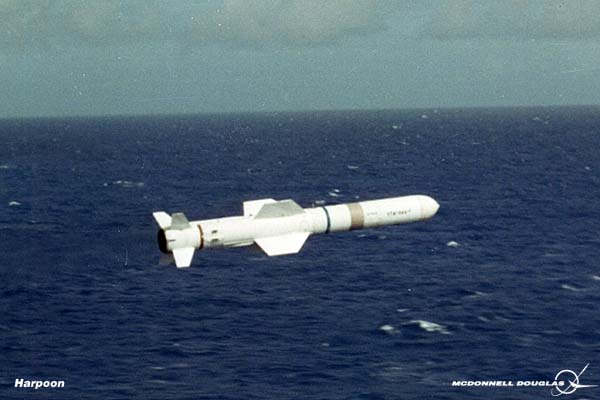
This increasingly dire shortage of ASuW firepower is about to be set right.
The next generation of anti-ship missiles is set to come on line shortly. Among them is a new and very accurate version of the Tomahawk that has performed superbly in tests, and can attack moving surface targets (and tell Good Guys from Bad Guys) at ranges as great as 1,000 miles. It can attack at such long range by taking instructions en route from other platforms, in the air, on the surface, and, one presumes, orbiting in outer space. The modifications needed to turn the Tomahawk from a land attack weapon into something that also hunts ships are not great, using current technology, and this is a low risk project; a major effort to “recertify” existing missiles and upgrade them for anti-shipping missions is now in the works.

Improved Tomahawks are fine, but they’re still rather slow and vulnerable, in the same way as Harpoon. Thus the Navy is also looking at a ship-based variant of the stealthy, air-launched Long Range Anti-Ship Missile, a slippery, pack-hunting weapon which, it would seem, is measurably more intelligent than the average community college sophomore.


LRASM is another low-risk development, based on the capable and proven Air Force Joint Air-to-Surface Standoff Missile, a low observable cruise missile with a range of over 200 miles. It’s meant to operate without much external assistance, and to discriminate among available targets based on their value to the enemy, and the threat they pose. Unverified internet chatter claims they can talk to each other and coordinate their attacks, and apparently they’re smart enough to react to unexpected threats and amend their own mission plans as needed to compensate.
Also in the pipeline is the Norwegian Naval Strike Missile, a stealthy sea-skimmer that can hit targets up to about 100 miles away. These have been tested on a Littoral Combat Ship, and will soon greatly increase the striking power of those vessels, redressing to some extent the lack of firepower that today blights both LCS designs; the missile was emplyed by the LCS Gabrielle Giffords in a SINKEX exercise in 2019, conducted successfully off of Guam. This weapon is considered a great success, and is already a mature system deployed in a few navies around the globe, and soon to be purchased in an air-dropped version for use by F-18s and the F-35C. It even has a land attack mode, and is good at discriminating targets amidst the clutter of shoreline radar returns, making it a natural for the LCS, which is, after all, supposed to be good at fighting in littoral environments.

Perhaps better still is the addition of an anti-surface mode to the SM-6 ERAM. Standard missiles have always had an anti-surface mode, but an SM-2, being a semi-active homer requiring ship-based target illumination, was restricted to line of sight engagements (out to about 10-15 miles). With its active seeker head, the SM-6 could be ripple fired at surface targets up to 250 miles over the horizon, using targeting data passed on from other platforms (like AWACS, or drone scout aircraft).
The warhead on a Standard missile is relatively small, about 140 pounds of blast-fragmentation. This is much smaller than the usual anti-ship missile, yet the prospect of, say, 6 of these things screaming down on you from out of the blue at over Mach 3.5 would surely be terrifying. Despite coming at you from high altitude (SM-6 cannot have a sea-skimming mode), where it can be detected at greater distances, ERAM presents a slim radar profile, and its blistering speed would make it very hard to intercept.
Disclosure of the details of a test shot conducted in 2016, in which an SM-6 sank a decommissioned frigate, suggest that the missile may have an impact/penetration mode, rather than being restricted to proximity detonation like many SAMs. But even in proximity blast/fragmentation mode, their blast warheads, detonating close to target, would shred radars and other sensors, destroy exposed aircraft on deck, and penetrate the hulls of most ships with deadly shrapnel. One can imagine it wiping out the bridge crew and anybody else not safe behind the sort of armour lacked by most modern warships. It would be like blasting the enemy combatant with a giant shotgun. This would not usually sink anything larger than a missile boat, but it would certainly put a battered and well-perforated target out of action (achieving a so-called “mission kill”).
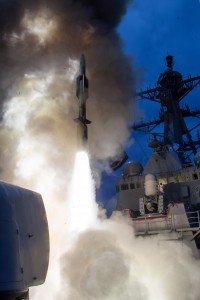
An added bonus is that no missile tubes dedicated to AAW need to be sacrificed to add this capability. The same ERAMs fill both roles.
Further down the road are hypersonic weapons, all the rage these days, which may well fundamentally change how surface warfare is conducted in years to come. The Navy is known to be working on such systems, playing catch-up with the Russians, who are now deploying their own hypersonic SSM called Zircon, but no details have emerged. (The problem of defending against such weapons is discussed further below).
Anti-Submarine Warfare
This is another neglected area that is starting to receive much greater emphasis. Just as the Navy permitted atrophy in ASuW over the past two decades, it behaved as if the end of the Cold War forever eliminated the need to hunt capable submarines of a sophisticated enemy fleet. One important ASW asset was lost forever with the retirement of all of the S-3 Viking squadrons from carrier air wings; the robust, integral anti-submarine capabilities they provided to the CBGs won’t be coming back. This is a pity.
However, the Navy is now procuring the Boeing P-8 Poseidon, a very advanced patrol aircraft derived from the 737, which succeeds the venerable P-3 Orion. The relevant Wikipedia entry does the machine justice:
The P-8 conducts anti-submarine warfare (ASW), anti-surface warfare (ASuW), and shipping interdiction, along with an electronic signals intelligence (ELINT) role. This involves carrying torpedoes, depth charges, SLAM-ER missiles, Harpoon anti-ship missiles, and other weapons. It is able to drop and monitor sonobuoys. It is designed to operate in conjunction with the Northrop Grumman MQ-4C Triton Broad Area Maritime Surveillance unmanned aerial vehicle.
The P-8 mounts all manner of state-of-the-art electronic gizmos, from synthetic aperture radar to advanced sonobuoys, and a highly sophisticated, gyro-stabilized, infrared/electro-optical system that includes high-definition TV, an image intensifier, a laser rangefinder and a laser illuminator. While lacking an integral magnetic anomaly detector of the sort boasted by its P-3 predecessor, there is word of a drone being developed that can skim low with “MAD” sensors and communicate to the patrolling Poseidons:
Overall, this plane bids fair to be a game-changer.

Aboard ship the improvements are perhaps more incremental. The primary ASW system aboard cruisers and destroyers is designated SQQ-89, now at version V.15. This coordinates and analyzes data picked up by the hull sonar (typically SQS-53C), sonobuoys dropped by helicopters, and towed sonars, to date the Tactical Towed Array System, “TACTAS”. The processing capabilities of the SQQ-89 system are being greatly upgraded, and a new towed array to replace TACTAS, the “MFTA”, or Multi-Function Towed Array, is just coming into service. It’s a much improved towed system capable of both active “pinging” and passive listening.

US Naval officers talk about the new system providing a “quantum leap” in ASW capabilities for surface warships, but submarines, at least to this bystander, remain a terrifying threat, hard to counter. Modern diesel subs, which operate on batteries when submerged, are so quiet they’re often referred to as “holes in the ocean”, and the latest models feature Air Independent Propulsion systems that allow them to run submerged for weeks at a time. In exercises a few years ago, subs of this sort operated by Sweden were able to repeatedly penetrate the defences of a CBG with distressing ease. Improved sonars are great, but one can’t help but feel something more radical is needed.
Enter new robot warriors, developed initially in an experiment funded by the Defence Advanced Research Projects Agency (oh those scamps at DARPA, what will they think of next?), which aimed to create a fairly large drone sub-hunting vessel capable of independent operations. The first images of the prototype were released in 2016, and a fair amount of publicity has attended the project since then. While little is yet known about the machine’s full capabilities, the Navy’s enthusiasm to date indicates that the system shows great promise, and it appears that the future USN will almost certainly include a fleet of such autonomous surface and sub-surface robot hunters, methodically scouring the deep for hostile submarines.


DARPA named the surface prototype, rather prosaically, the Anti-Submarine Warfare Continuous Trail Unmanned Vessel, probably so that another of the Pentagon’s beloved acronyms could be attached (“ACTUV”). The “continuous trail” aspect involves the units locating and then shadowing submarines, sticking with the quarry in tireless and relentless fashion, while feeding constant updates to friendly forces on their whereabouts. No one, so far, is talking about having these robots prosecute autonomous attacks on the subs they trail, which will probably come as a relief to the friendlies they’re bound to latch on to from time to time. The aim is to pay special attention to the world’s proliferating fleets of those quiet and elusive diesel-electric submarines. Presumably these sub-hunting drones will be made of stealthy materials and be themselves very quiet, so as to evade enemy “delousing” efforts, and avoid tipping off the quarry.
ACTUV completed trials with DARPA in January, 2018, and was then handed over to Office of Naval Research, which refers to it as the Medium Displacement Unmanned Surface Vehicle, “MDUSV’, though it also goes by the name Sea Hunter. In an impressive display of autonomous navigation, the unit sailed from San Diego to Hawaii and back on its own, completing the mission at or around the beginning of 2019. The Navy sees a role for these vehicles that extends beyond ASW to tasks such as electronic warfare and scouting, decoy missions, and, in larger versions as “arsenal ships”, floating magazines to augment the missile capacity of surface combatants – more on this below. In the meantime, a sister vessel to Sea Hunter, named Sea Hawk, has been delivered, and operational experiments continue. In the long term, such vessels may form a standard part of the carrier battle group escort screen, and may even be armed, with a human operator in the loop, remotely, to authorize weapons release.

If the subs evade the attentions of ruthless drones, slip by the patrol aircraft, and get past escort vessels, their torpedoes can still be confused or decoyed by various devices like the “Nixie” defence system, which deploys units that create enticing acoustic signatures for torpedoes to chase.
Wake-homing torpedoes are immune to such countermeasures, and over the past few years projects to provide vast improvements in torpedo defence have been funded. One of the most exciting was the Surface Ship Torpedo Defence Program, which, had it succeeded, would have given warships an active counter to torpedo attacks in the form of a sort of anti-torpedo interceptor – a torpedo to attack torpedoes. The “Countermeasure Anti-Torpedo” was paired with a towed torpedo warning system, supposed to be able to detect and track incoming torpedoes for the CAT to engage. Three systems were installed on Nimitz class carriers for trials, but results were disappointing. The towed warning system proved prone to false alarms, and the reliability and effectiveness of the CAT was judged to be doubtful. A decision to suspend the at-sea testing was announced in September 2018.
The program isn’t dead, officially, and one hopes that it might yet be made to work. Reports describe the system as improving, with some demonstrated capability, but not yet enough to be useful. Here’s hoping that testing and development continue. If CAT or something like it could achieve operational effectiveness, it would provide the USN with the one of the few “hard kill” torpedo defences deployed by any navy, surely a goal worth pursuing.


Something similar is being developed for the submarine force under the rubric of “common very light weight torpedo”, a prototype for which was revealed in May, 2020 by Northrop Grumman. It looks a lot like the CAT, actually, and appears to have been developed from a similar specification. The small, fast torpedo is said to have the interception of other torpedoes as one of its design goals, and if it works in that role one wonders if it could be adopted for use by surface vessels.

A typically excellent and comprehensive survey of the world’s many torpedo countermeasure systems, both active and passive, can be found on the War Zone site, here:
The author, a retired US Navy sonarman named Aaron Amick, opines at the end that the sophistication of modern countermeasures, particularly active anti-torpedo weapons like Rafael’s “Torbuster”, developed in Israel, and other similar systems, are rendering the conventional torpedo obsolete. Not to pick sides in the ongoing struggle between skimmers and submariners, but here’s hoping he’s right, at least when it comes to defending the US Navy’s surface fleet.
Fire Support
Armchair admirals like the writer have been moaning for years about the absence of the kind of naval gunfire support that used to be dished out by the Iowa class battleships, prior to their retirement in the 1990s. The Mk. 45 5” 54 calibre guns which for decades were the principal guns mounted on most of the Navy’s surface warships are mature and useful weapons, accurate and reliable, with a high rate of fire – but with a range of about 13 miles they provide only modest reach. This shortcoming has been at least partially corrected.
For several years now, new units of the Arleigh Burke class of destroyers have been delivered with the improved Mk.45 62 calibre gun, the longer barrel of which, according to some sources, can fling five-inch rounds over 20 nautical miles – almost as far as the 16 inch guns of the Iowas, albeit with far, far less hitting power.

That’s fine if true, but given the present technological possibilities, a 50% range increase for small unguided projectiles might best be described as “meh”. So much more is now possible, and for more than a decade, the Navy has seemed poised on the threshold of a quantum leap in the reach, accuracy and hitting power of naval gunfire. This constant state of “nearly there” has been frustrating, since from a purely technological standpoint there seems to be no reason why ships shouldn’t already be firing finned, rocket-assisted, GPS-guided projectiles with ranges of up to more than sixty miles. Efforts to develop such extended range guided munitions were pursued by the Navy for years, haltingly, but that project was allowed to lapse. Instead, functionally similar technology was perfected for the Army – standard land-based 155 mm. artillery pieces now fire guided shells named “Excalibur”, which achieve extended reach by virtue of aerodynamic surfaces that pop out during flight, turning the shell from mere projectile into a sort of glider. Hundreds of rounds have been used in combat in Iraq and Afghanistan over the past few years, with spectacular success.
The wing-assisted Excalibur rounds are so accurate, that at ranges out to over 20 miles they can be used to provide what would once have been prohibited “danger close” fire support, impacting as little as 250 feet away from friendly forces. The shells are uncannily precise; using fin guidance they manoeuvre to arrive on target in vertical dives, rather than sloping ballistic arcs, with over 90% falling within 10-12 feet of target. This, mind you, under field conditions in live combat. In effect, the standard 155 mm howitzer becomes an F-16 loitering permanently on station, dropping GPS-guided bombs promptly upon demand.

This would therefore seem to be just the ticket, and sensing the obvious, Raytheon has hyped the development of a smaller 5 inch version that could be fired from any Mk.45 gun, perhaps tripling its range. Were this to go anywhere, every destroyer and cruiser in the fleet might be able to drop guided shells precisely on target at ranges from 40-60 miles. Raytheon is also touting a version with a millimetric wave radar seeking head, for use against moving naval targets (swarming boats are the usual threat meant to be addressed by this sort of advanced gunnery). It all sounds very promising, but so far, none of this has amounted to much, and Raytheon has moved on to promoting a larger six inch round that could be used by the new gun systems of the Zumwalt class destroyers, thus far without generating much enthusiasm among the Admirals.
There’s a sad and all too typical story behind Raytheon’s latest initiative. The Zumwalts desperately need some sort of ammunition they can use. The ships of the class mount two Mk. 51 155 mm Advanced Gun Systems – which look thoroughly deadly and futuristic in their stealthy turrets – specifically designed to fire a round conceptually similar to Excalibur: the guided Long Range Land Attack Projectile, the reach of which has been demonstrated to between 60 and 70 miles. Sadly, it turns out that owing to the drastic cut in the production run for the ships, and consequent loss of economies of scale, a single LRLAP costs about $800,000 US, a punishing price tag that even the US Navy can’t afford. Let that sink in. A solitary round is stated to cost US $800,000, and if it’s officially that much, you can bet it’d be a million when delivered. This leaves the Navy in a bit of a pickle. The guns’ peculiar design doesn’t permit them to fire any old 155 mm round, and in any case ordinary ammunition has far less range than needed for the mission – hence Raytheon’s interest in proposing a variant of the Excalibur. This appears to be a logical alternative, but Raytheon’s lobbying efforts have so far come to nought, and the Navy has announced that there are no current plans to do anything at all to arm the guns of the new destroyers, apparently having opted to take a “wait and see” approach.
Another logical and very compelling possibility is provided by the new “Vulcano” ammunition developed by BAE Systems and Leonardo as a joint enterprise, with the goal of vastly extending the range of conventional naval (and land based) artillery. The new rounds are conceptually similar to Excalibur, described in BAE press releases as “capitalizing on new and emerging technology based on a fin-stabilized airframe with canard control for extended range and terminal guidance, with mechanical interfaces that are the same as standard ammunition”. They come in both 5 inch and six inch calibre, and can be either ballistic rounds or guided projectiles (using GPS as a default, but according to BAE, easily augmented by infrared and/or laser seeking systems, for use hitting land targets designated by infantry ashore), both with extended range, and both compatible with most existing guns. The prospects for improving the gunfire potential of US Navy platforms is illustrated in this table produced by BAE:

Note the presence of two gun systems of particular interest: the standard 5 inch Mk. 45, and the six inch Mk. 51 Advanced Gun Systems installed on the Zumwalts. Vulcano, it seems, could satisfy almost all of the US Navy’s requirements for advanced, long range, guided gunfire support.
Yet there’s no sign, thus far, that anybody wants to leap at the opportunities now available. With the Admirals unable to see something they liked at a price they can stomach (one could almost see the Raytheon and BAE reps jostling and shouting “Hey! Over here!”), the Zumwalts in particular, purpose-designed at fantastic expense to provide fire support to forces ashore, have been scrambling for a mission to fulfil using only their 80 VLS missile tubes. At present, there’s talk of employing them as stealthy hunter-killers that destroy enemy surface units, perhaps by loading them up with the LRASM – but this could be nothing more than a PR exercise, as the Admirals struggle to justify the existence of their hugely expensive white elephants.
For a while, it looked like there might yet be an answer. Even something like Excalibur would have looked like nothing special if a class of weapons once seen only in science fiction – electro-magnetic rail guns – had begun to show up on the decks of US warships. Until recently, this didn’t seem like a long-term, pie in the sky ambition. By all accounts the technology was ever so close to being perfected, and it was being reported that a prototype was on the cusp of sea trials, predicted to begin before the end of 2019.
It never happened.
This was a very great disappointment to many of us out here in the peanut gallery, since the promise of such weapons seems enormous. Working rail guns would be able to fire guided shells at unprecedented velocity out to unheard of ranges, as fast as Mach 7 and as far as 100+ miles. Given the right guidance systems they might even be accurate enough to serve in the AAW role, even downing incoming ballistic missiles, at a cost lower than something like an SM-3 by a factor of as much as 120 (an SM-3 costs about 11 million dollars, while a rail gun projectile costs about 90 thousand). If the accuracy of guidance packages for rail gun rounds lived up to projections, an Aegis defender could have hundreds, instead of a couple of dozen, anti-missile rounds at its disposal. Moreover, rail guns would hold pretty much any target, however large and robust, at grave risk; indeed, so much kinetic force is exerted by the impact of a hypersonic rail gun round that the munitions weren’t even designed to incorporate warheads. No need. Targets ashore could be pummelled, and there’s no reason there couldn’t be a version with a terminal seeker, for firing at enemy warships. Another potential game changer, if it could be made to work.

Yet, the Navy’s enthusiasm for electromagnetic artillery waned in recent years. This seemed in part because the development of rail guns also had an impact upon conventional “powder” guns, with the realization that the sleek hyper-velocity rounds designed for the electric system could just as easily be propelled up gun tubes by the expanding gasses of gunpowder. This has been reported to allow conventional guns to throw shells around at the same speed as rail guns, see for example:
Not likely – the speed of the 5 inch HVP is elsewhere, and more plausibly, reported to be Mach 3, still a little faster than most conventional naval shells (though there are 5″ rounds in service today that are already reported to reach that muzzle velocity), and this purportedly translates into increased range and hitting power. This might have seemed a cheaper, easier, faster way to go.
More important, and unfortunate, was that testing revealed a number of problems related to rate of fire, barrel longevity, and electrical requirements, issues that may be inherent in the laws of physics and thus not readily overcome with current technology. This is an interesting article that details some of the problems:
There it sat for a while, with the rail gun apparently on life support, while the HVP provided a still promising second best alternative. Then, in a move that disappointed many, the 2021 budget requests indicated that both the rail gun and the HVP seem to have been abandoned:
Congress continued to throw money at the program in the FY 2022 appropriation, while demanding an explanation as to what’s gone wrong, but the Navy didn’t ask for the funding, doesn’t want it, and has obviously concluded that the thing won’t work. They’ve likewise abandoned the High Velocity Projectile. This seems a great pity, given the potential for vastly increasing ship firepower inherent in these programs, particularly the HVP, which aimed to deliver guided projectiles to the gun magazines of cruisers and destroyers, without requiring any major changes or upgrades to the vessels or their guns, that could have provided a much more numerous and vastly cheaper alternative to missiles in some combat scenarios. The possibilities were amply demonstrated in 2020, when the U.S. Army and Air Force conducted a joint experiment in which a BQM-167 target drone, standing in for a subsonic cruise missile, was downed by guided shells fired from a155mm self-propelled howitzer:

Five inch HVP rounds were successfully tested during the same exercise.
Think of it: downing cruise missiles with bog-standard 155 mm self-propelled artillery! This followed on the heels of another test in which USS Dewey, a Burke class destroyer, completed a barrage of 20 HVP rounds at sea during the RIMPAC exercises in the Summer of 2018.
Sitting out here on the sidelines, the promise of these developments seemed terribly exciting, but the Navy has lots of competing priorities, and the Admirals were, apparently, insufficiently impressed. For now, there will be no long range guided artillery for US warships. The long-awaited revolution in naval gunnery seems always to remain, maddeningly, just over the horizon.
In November 2021, plans were announced to entirely remove the Advanced Gun Systems from the three Zumwalts and use the space for large hypersonic land-attack missiles now in development, putting a sorry end to the debacle.
Something more cheering: once again, the SM-6 has an applicable targeting mode. Because it contains a GPS, it can be fired at fixed targets ashore, and while this would be a rather expensive way to attack the average bunker, there are certainly high value targets that would merit the use of such missiles. The latest generation of Russian SAM systems, like the S-400, comes to mind. Putin has deployed this system in Syria as a way to intimidate Western forces; a destroyer 200 miles out to sea could take it out with a fusillade of rounds travelling faster than high velocity rifle bullets, each with more than twice the reach, and packing about twice the punch, of missiles like HARM that were designed from the outset to hit enemy radars.
This SM-6 is something, no? Over the horizon aerial and surface engagements, taking out sea-skimmers and even low-flying cruise missiles over terrain, intercepting all manner of aircraft, blasting ballistic missiles, sinking ships, and now, perhaps, assaulting high value targets ashore. There may be no such thing as an “I wish you were dead” missile, but this latest version of Standard is coming close.
Aviation
CVN-78, lead ship of the new class of super-carriers, has indeed suffered through a troubled gestation, so much so that at the end of the Obama administration, when it became obvious that the new vessel class had all but left the rails, the program was subjected to a highly critical official review. Its problems stem from a recent Pentagon procurement fad called “concurrency”, which was premised upon the idea that it’s possible, with the aid of advanced computer simulations, to develop multiple new systems at the same time as the platform intended to carry them. Thus, you start building the ship and installing its various systems before those systems have been tested and proven. With the Ford, this meant new radars, catapults, arresting gear, propulsion, power generation and distribution, and even new ammunition elevators, all being developed and installed at the same time.
All of those systems have experienced problems that go well beyond “teething troubles”, bad enough that at times they’ve seemed to threaten the viability of the ship. In a memo to the Secretary of Defence written as Obama’s tenure drew to a close, successfully advocating a comprehensive program review, it’s stated:
“With the benefit of hindsight, it was clearly premature to include so many unproven technologies in the Gerald R. Ford. That decision was made long ago as part of a DoD level initiative called ‘Transformation’… What we have to determine now is whether it is best to stay the course or adjust our plans, particularly for future ships of the class. The first step in that process has to be a completely objective and technically deep review of the current situation.”
Now here we are having weathered the Trump administration, Joe Biden is President, and still the ship has most of the same issues, slowly improving but not fully resolved, such that the sentiment of the Obama-era report was echoed in July of 2021 by the Chief of Naval Operations, Adm. Michael Gilday, who told reporters that the decision to implement almost two dozen new technologies on the lead ship of the class was a painful mistake from which the Navy has learned a great deal, and won’t make again:
https://breakingdefense.com/2021/07/cno-too-much-new-tech-on-ford-was-a-mistake/

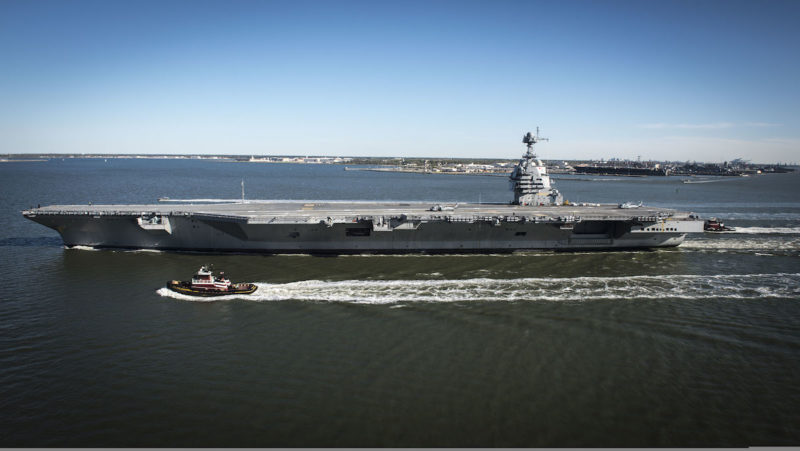

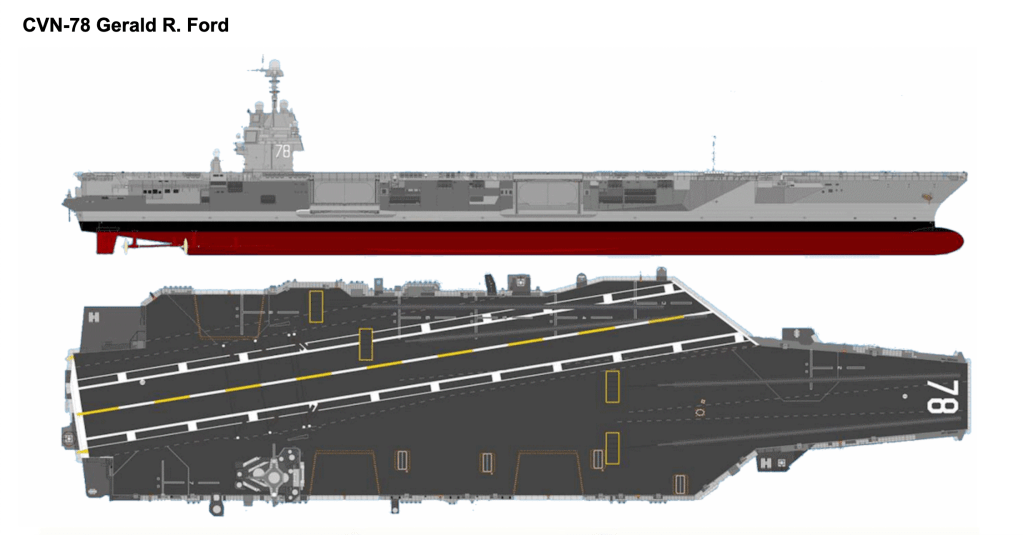
The concurrency developmental strategy has also bedeviled both the Littoral Combat Ship and the F-35 program, and a military historian might recall that the goal of developing multiple crucial systems at the same time as the platform was a key factor in dooming Canada’s Avro Arrow fighter-interceptor back in the 1950s.
The Navy will get a grip on the Ford class, because it has to, but here it is approaching the end of 2021, and issues persist. The vessel’s date of entry into operational service keeps getting pushed back, and some of the new systems may be swapped out for proven technology (particularly the troublesome Dual=Band radars), while follow-on units may abandon some of the new systems altogether until they can be proven (though this might not be possible, particularly since the all-electric ships simply aren’t designed to distribute high-pressure steam around the vessel to catapults and such); but whatever it takes CVN-78 and her follow-on sisters simply must be made to work, no doubt, sadly, at vastly higher expense than was necessary. Once cured of their many ills, the Ford and her sisters will doubtless supply a significant improvement in war fighting capability over the prior Nimitz class ships. After all, on paper, CVN-78 is a beast of a vessel, with a 5 acre flight deck (half an acre bigger than the Nimitz class), and numerous improvements, small and great, that could make it superior to its predecessors in almost every way. At the time of writing (January, 2022) the program barrels ahead, with no public indication of any significant redesign or equipment substitutions, save for the radars. The John F. Kennedy (CVN-79) is already well under construction, and Enterprise (CVN-80) was laid down in 2020.
At least two more units are in the works, and doubtless there will be others, so here’s hoping that the bugs are ironed out soon. Signs to date are moderately encouraging; as at May 2020, CVN-78 was still suffering problems with most of its advanced systems, including its nuclear plant – the weapons elevators have become a particular concern – and the failure rate of EMALS was still unacceptably high, though the Navy worked hard to certify this critical system in a series of tests conducted throughout 2020. The official line is that progress is being made, of course, though slowly; for example, as 2019 drew to a close only four of eleven weapons elevators were working, while it was reported in May 2020 that the capability to move weapons all the way from the magazines to the flight deck was only just achieved. As recently as May of 2021, four of the weapons elevators were still not serviceable; finally, in December, as the year drew to a close, it was announced that finally, all eleven elevators were fully functional. Performance of the catapults and arresting gear are also said to be improving by leaps and bounds, but challenges with a host of other systems remain. A very detailed review of the program can be found in the September 2021 briefing by the Congressional Research Service:
Despite every effort, the date of the Ford’s first operational deployment keeps slipping, and is now projected to come no earlier than 2022, five years after she was commissioned, which is, really, scandalous. On a happier note, long-delayed shock trials for CVN-78 were finally conducted in August of 2021, yielding spectacular imagery, and, as far as can be discerned from the public record, revealing no major issues with the ship’s ability to hold together in battle and keep functioning. In one test, a charge composed of 40,000 pounds of high explosive – 20 tons – was detonated close to the ship:

“We had zero catastrophic failures on the ship, zero situations where we had flooding or anything, and zero fires. All that is pretty significant,” said Capt. Paul Lanzilotta, the Ford’s commanding officer. So that’s nice to hear.
One day, we can only assume, the units of the Ford class will be mighty instruments of national power, despite the appalling hash that’s been made so far of their construction. Perhaps the long-delayed first deployment in 2022 will prove, at last, that the corner has finally been turned.
Similarly, this observer predicts that the F-35 is eventually going to confound all of its critics, many of whom spent the past few years filling the blogosphere with spectacularly ill-informed commentary on the aircraft’s myriad supposed flaws and performance limitations. After some serious (and rather discouraging) hiccups early on, including problems arising from the placement of the arrestor hook, the F-35C completed a highly successful set of carrier trials by 2016, and while it’s taken a while, the first operational squadron has now deployed aboard the Carl Vinson with VFA-147 (the Argonauts):

Despite the plane’s reported shortcomings in aerodynamic and kinematic performance, about which rather too much was made some years back (many of which were neither real nor relevant, while others were of a sort correctable with tweaks to the control laws in its fly-by-wire software), the stealthy Joint Strike Fighter brings radical new capabilities to the fleet. Over the past few years, the naysayers who claimed the fighter was an aerodynamic pig, and easy meat for agile fighters of the prior generation, have been proved utterly wrong – in arduous, realistic air combat exercises such as Red Flag, the aircraft trounces all comers in air-air combat, racking up kill ratios in the 20:1 range, and its capabilities as a stealthy sensor platform are second to none, indeed revolutionary, and superior in many ways even to the F-22 Raptor. Complaints about the aircraft’s raw performance and all-around effectiveness have thus now largely been superseded by gripes about its logistical tail and the costs of maintenance, both, admittedly, areas of concern which will need to be addressed; few doubt, any longer, that the deployment of the new fighter marks a significant advance in strike and air combat capabilities for the Navy. Was it long overdue and well over budget? Yup. Was creating a “universal fighter” for the Navy, Air Force and Marines, including one version capable of hard carrier ops, and one featuring VSTOL technology, as hard as the most hard-boiled skeptics predicted? Uh-huh. Was its development a concurrency-plagued botch job just like the Ford? Oh, you betcha. In another five years, I’m betting, nobody’s going to care. Many of the same sort of attacks, remember, were levelled at the Tomcat and the Super Hornet in their time. In due course, all anyone will be talking about is the overwhelming technological superiority of these stealthy fighters, with their AESA radars, mind-blowing electro-optical systems, unbelievably sophisticated passive and active electronic warfare and intelligence suites, and pilots who have helmets that allow them to see right through their own cockpit floors.
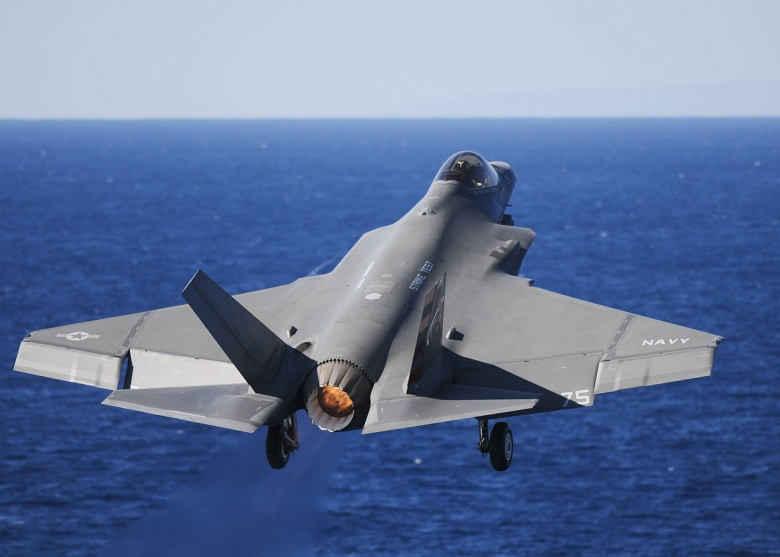
There’s a reason that every competent air force on the planet, including Israel’s, is eager to acquire them.
At some point, barring resistance from the all-too-human fighter jock community, carrier air wings could well be supplemented by stealthy high performance drones that have very long legs, and flight characteristics comparable to modern fast jets. The way forward was demonstrated years ago with the X-47 program, an unexpectedly (and perhaps, for some, unnervingly) smooth success, and something descended from that technology demonstrator is almost certainly the long-term future of naval air power.

A decision has already been taken to use something conceptually similar to act as a mid-air refuelling aircraft, recently designated as the MQ-25 Stingray, the design competition for which was won in September 2018 by Boeing, with this promising-looking prototype:

Testing has proceeded to the point that aerial refuelings are now taking place, as seen here, with an F-18 taking on gas:

E-2D Hawkeye AWACS aircraft and F-35 fighters have also been successfully refuelled in tests, and initial carrier trials – which involved very preliminary tests of functionality around flight deck handling, and installation of its control system below decks – were conducted on the George H.W. Bush as 2021 drew to a close:

It’s too early to even begin to understand the full implications of all this. The mind boggles. Just for a start, a key benefit of a drone tanker force would be an expansion of the radius of action for the carrier’s aircraft, for which aerial refuelling was always a possibility, but one that required the use of precious tactical combat aircraft in “buddy refueler” configurations, an unsatisfactory solution that keeps jets out of the fight. Stealthy drones could loiter safely, waiting for customers, while freeing up valuable assets to go about better things. As potential adversaries like China develop ever more capable long-range weapons for “area denial”, the importance of extending the reach of carrier aviation has become critical. Unmanned aerial vehicles could be the perfect airborne refuelling solution, and a big part of the overall answer.
They could also take up responsibilities for electronic warfare, and anti-submarine patrol, either alone or in concert with manned aircraft, acting as “loyal wingmen”. For example, efforts to pair the manned P-8 patrol aircraft with unmanned MQ-4 Triton UAVs are well advanced, and several of the world’s air forces are looking into the loyal wingman concept as a potential force multiplier, among them both America’s and China’s, of course, but Australia, too, which has an advanced program underway.
But what of naval combat? Why not armed UAVs and loyal wingmen for the carrier air group? There was once talk in US naval circles of evolving a design like the X-47 into a remotely piloted strike aircraft, under the acronym UCLASS, for Unmanned Carrier-Launched Airborne Surveillance and Strike. It made a great deal of sense, on several fronts. While not quite expendable, unmanned combat aircraft would probably be less expensive than the F-35 and its sixth generation successors, and far less painful to risk and lose in combat. Stealthy unmanned vehicles might also have longer range than current tactical aircraft, being simpler, and thus lighter. A carrier might be able to expand the size of its air wing, too, without the need for the exquisitely trained and highly expensive pilots that lately are proving harder and harder to come by. Not long ago, as the X-47s demonstrated an astounding ability to autonomously land and take off safely from aircraft carriers under real world conditions, it seemed obvious that further development of the concept would proceed at full speed ahead. Not so much, apparently.
As with extended range guided artillery, the Navy seems to be less excited at the prospect than those of us who cheer from the sidelines. The initial objectives of the X-47 program were attained, and then the prototypes were put into storage. No further development is planned. There’s talk that the drones might be scrapped, or at least taken apart and stored indefinitely. Perhaps powerful players in the naval aviation community don’t like the idea of completely effective combat aircraft operating unencumbered by fighter jocks in the cockpit? Is a golden opportunity being squandered?
If so, there may still be some consolation in the possibility that drones of a different sort could soon disperse significant fixed-wing air power throughout the fleet, deployed on anything that has a hangar and a helipad.
Yes, DARPA’s been at it again. Those guys! In 2013 they commissioned Northrop-Grumman to build a prototype flying wing drone, called “TERN” (for Tactically Exploited Reconnaissance Node – boy these guys love their contrived acronyms), festooned with sensors and weapons like the Hellfire missile, that can land and take off vertically from the same decks that destroyers and cruisers now use to operate Seahawk helicopters.
Not much has been published about TERN over the past couple of years, but surely something along these lines is both well within the scope of mature, off-the-shelf technologies, and potentially revolutionary in its impact. Again, the tactical implications are at present a bit difficult to grasp. These drones could provide remote targeting information, and an ability to prosecute air strikes against soft and not-so-soft targets. It’s a simple and simply brilliant idea.
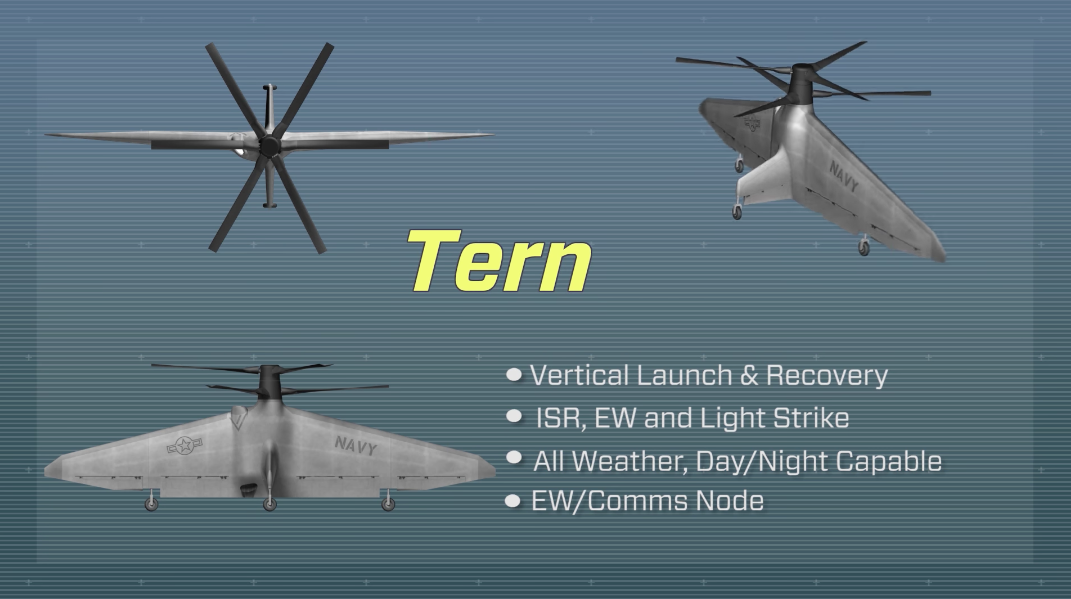
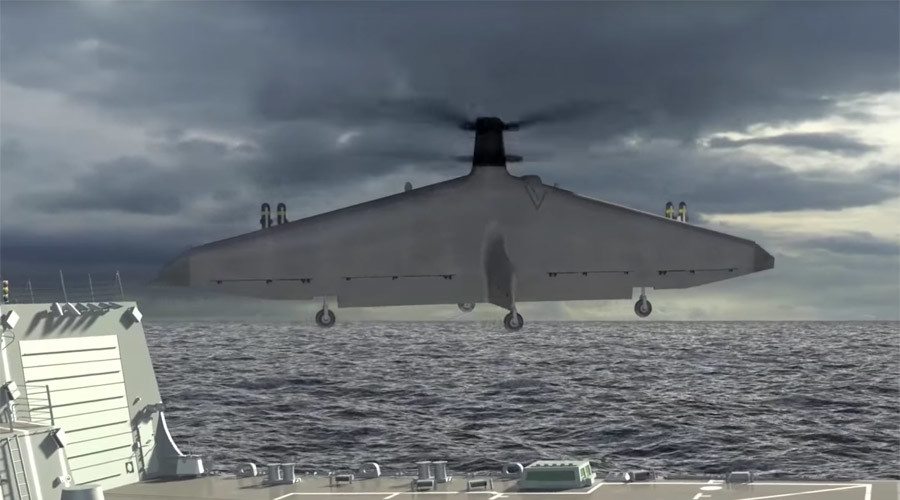
Some semblance of this capability exists already, in the operational Fire Scout helicopter drone.
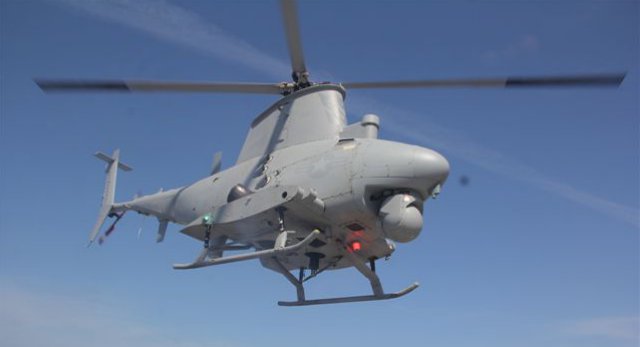
At some point, the Navy has to recognize that unmanned aircraft of all sorts are going to be vital to the continued successful use of sea-based airpower.
Right?
Passive Defensive Systems
For decades, US warships have relied on electronic countermeasures antenna arrays designated SLQ-32. The “Slick 32” is supposed to detect and jam hostile radar transmissions, particularly those on incoming missiles, but by the early 2000s it was clear that its best days were behind it, and the word was that many modern anti-ship missile systems operate outside its frequency limits – meaning it wouldn’t even see them coming.

This is still another area where the Navy has been asleep at the switch, and a multi-billion dollar effort is now underway to improve electronic defensive capabilities under the Surface Electronic Warfare Improvement Program (“SEWIP”).

A sort of passive cooperative engagement capability may be part of the picture. SEWIP devices might be able to network between platforms, providing not just jamming but what amounts to wi-fi on steroids. If SEWIP could provide the bandwidth necessary (more than current data links like Link 16), it would be possible to coordinate electronic warfare across the fleet, and work communally, the SEWIP antennae helping each other out instead of sitting there doing nothing while other assets are threatened. Ships, airborne jamming aircraft like the EA-18 “Growler”, and even drones, could combine their EW efforts into a networked system that might blind an entire enemy force, providing a blanket of protection, rather like a smoke screen made out of electrons. SEWIP might also team with the new AMDR radar, which itself has the ability to aim narrow beams projecting massive amounts of radio energy at discrete targets, blinding them, and even frying them. Apparently, AESA radars can also be used to transmit malicious data, inserting computer viruses into the enemy’s guidance software.
SEWIP antennae, still designated SLQ-32 (SLQ-32(V)6, in the latest iteration A.K.A. SEWIP Block II), are now increasingly widespread across the fleet:
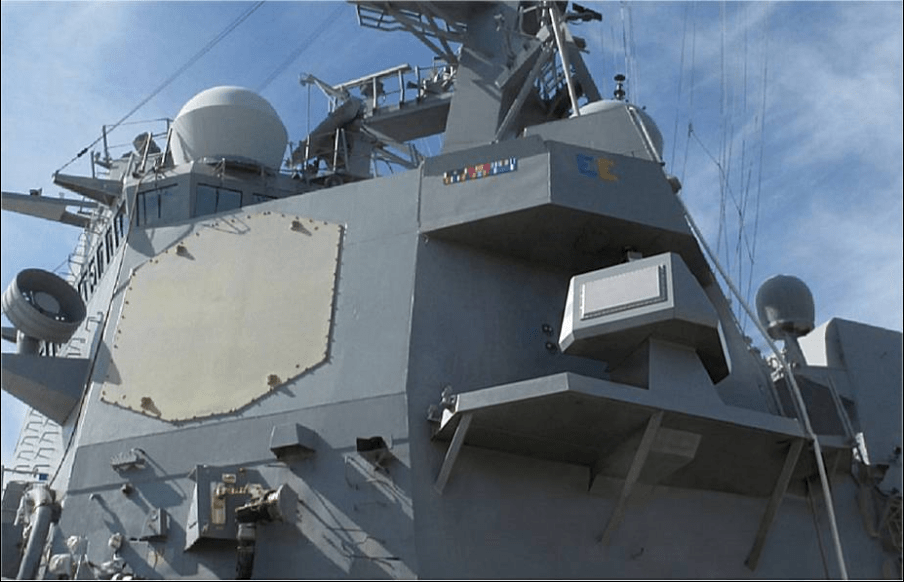
These are sometimes nicknamed “SEWIP Lite”, despite being massively more effective than the units they replace. They rate the “Lite” designation only when compared to the next iterations of the SEWIP installation, now undergoing testing, which are obviously of a much higher order of capability, being large enough to change the overall profile of their host ships, and festooned with what must be tremendously powerful transmitter and receiver antennae for prosecuting the whole range of defensive, and no doubt offensive, electronic warfare techniques. Have a look at the AN/SLQ-32(V)7, a.k.a. SEWIP Block III array:

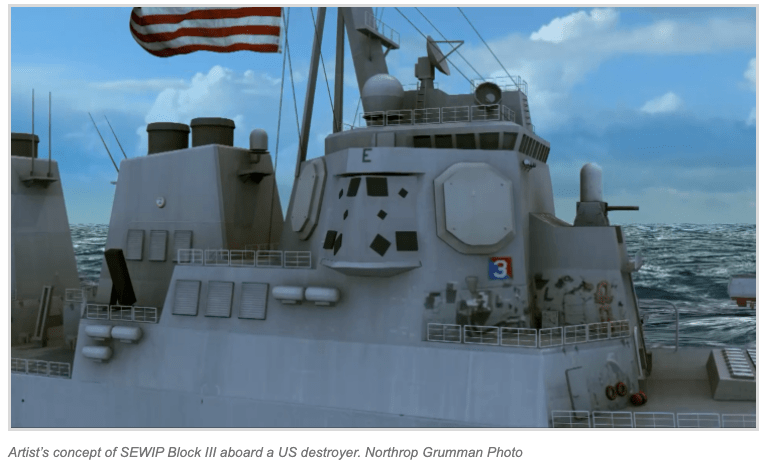
The first engineering and development model of this monster was delivered to the Navy on June 11, 2021. Formal land-based testing will now proceed at the Naval Sea Systems Command Surface Combat Systems Center in Virginia. With SEWIP Blk. III, the system will no longer be classifiable as “passive”. Its antennae will not merely detect and jam the emitters of incoming missiles, but actively assault them with burts of energy powerful enough to stun them into insensibility, much as AMDR is said to be able to do.
Electronic countermeasures, rather than missiles or even lasers, may therefore provide the best defence against the ballistic and sea-skimming missile threat. If incoming weapons, and their launch platforms, can be spoofed, infected, or fried stupid, it doesn’t matter how fast or powerful they are. They’ll be punching into air.
Or punching at ghosts, as US ships mount an array of physical decoy systems, from Rapid Blooming Overhead Chaff, to hovering decoys named “Nulka” (a joint project with Australia – “nulka” is an indigenous word for “fast”), none of which is particularly new, but which provides another set of false radar returns for missiles to chase.
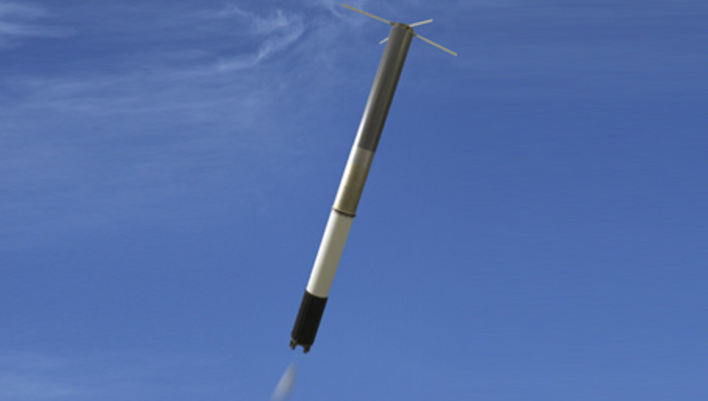
The capability to fry the guidance packages of incoming missiles may not be restricted to the AMDR and SEWIP. New CIWS systems relying purely on powerful microwave emitters are now under study, and BAE systems has been showing off a model at recent military trade fairs (yes, weapons merchants participate in the same sort of marketing events as auto makers and purveyors of home electronics). Such a system would give auxiliaries and much smaller vessels some of the capabilities now under development for the Navy’s high-end DDGs. A good discussion of the system and its potential is discussed here by Tyler Rogoway at his excellent blog, The War Zone:

A Step in the Right Direction: “Real” Frigates at Last
The Littoral Combat Ship, mentioned somewhat derisively at the beginning, has come to be recognized as a failed concept. As originally envisioned, the ships would have been outfitted with versatile, “swappable” modules, allowing combat systems and armaments to be changed for different missions – a sort of “plug and play” concept that looked fabulous on paper. One mission, it could be an anti-surface hunter-killer, the next an anti-submarine patrol vessel, or a minesweeper, and so on. Like so many such concepts, it was too ambitious, and the modular approach has been abandoned, at least inasmuch as it envisioned rapid and easy swapping of the modules between missions. Meanwhile, while very fast (40+ knots), the vessels that have emerged, at a cost of over 600 million USD apiece, are thin-skinned, very lightly armed, and prone to breakdown. Various proposals are being made to add to the punch of these vessels, including the addition of anti-ship missiles such as Harpoon or the Norwegian Naval Strike Missile, but neither version of the LCS is ever going to stack up well against the proper frigate designs that fill the ranks of foreign fleets.
It’s not even clear that the vessels are viable mechanically. The ships of the Freedom class have experienced repeated failures in their propulsion systems, and neither of the variants has proved especially deployable or robust. The first two units have already been slated for decommissioning, and the Navy had announced plans to divest itself of many more, initially three of the Freedom class and one Independence, before this arrived in the 2023 budget proposal, as reported in The War Zone (https://www.thedrive.com/the-war-zone/44811/littoral-disaster-navy-wants-to-retire-10-littoral-combat-ships-according-to-report):


So if the Navy gets its way, there goes pretty much the entirety of the commissioned Freedom class, the oldest of which will have served less than seven years when it’s paid off and put into mothballs, perhaps eventually to be sent to the bottom in a SINKEX. Deliveries continue, but the Navy obviously has no good use for the vessels, can’t make them work, and wants to wash its hands of the whole mess, making the saga of the “Little Crappy Ships” yet another dispiriting, and altogether scandalous, example of hugely botched, hugely expensive procurement.
There’s one silver lining to this awfully dark cloud: recognizing the near total failure of the LCS program at last, the Navy issued a specification for a class of 20 warships that have all the attributes of conventional multi-purpose frigates, sounding on paper a lot like updated versions of the retired vessels of the Oliver Hazard Perry class. The ships are to have proper air defence and anti-surface warfare capabilities. Numerous contenders vied for the contract. While a re-worked and up-gunned version of the LCS briefly insinuated itself into the process, a much more appealing candidate was a variant of the Ingalls National Security Cutter, a tough and well-regarded design already in service with the Coast Guard. The makings of a potent frigate are already latent in the design:

Ingalls offered up multiple versions incorporating various levels of war fighting capability, and many, your faithful scribe among them, found it hard to see why the selection of some version of this vessel was anything but a no-brainer. Apart from anything else, it just looks right – it has presence, which is no small thing when it comes to navies.

Another, more exciting candidate was based on Spains’s F100 class frigate, which would have been even more attractive than the Ingalls design. The F100s use American systems, including the Aegis/Standard Missile combination, and at about 7,000 tons, with 48 Mk.41 VLS tubes, they’re more like what used to be called “destroyers” rather than frigates, being, in effect, smaller versions of the Arleigh Burkes.

The selection of this design, which, as an added bonus, was to have been built by the legendary Bath Iron Works, would have been absolutely delightful to those of us in the peanut gallery, but this was always a long shot. It’s not just that they were bound to have been more expensive than the alternatives; a choice like that would have been too good to be true, just on general principles.
You can read about the Bath proposal here:
In the end, those designs lost out to a variant of the European “FREMM” class frigate (the acronym stands for “European Multi-Purpose Frigate” as spoken in both French and Italian), proposed by Italian firm Fincantieri. At the beginning of the process, the FREMM design seemed something of a dark horse, but Fincantieri took what was already a highly-regarded design, and addressed weaknesses that might have ruled it out, giving it American weapons systems and beefing it up structurally to meet US Navy standards for combat survivability. Its radar fit will include a variant of the SPY-6, discussed above – a very potent system – and the specification is for 32 Mk.41 VLS tubes. No doubt, the Fincantieri design makes for an attractive and in many ways impressive vessel:



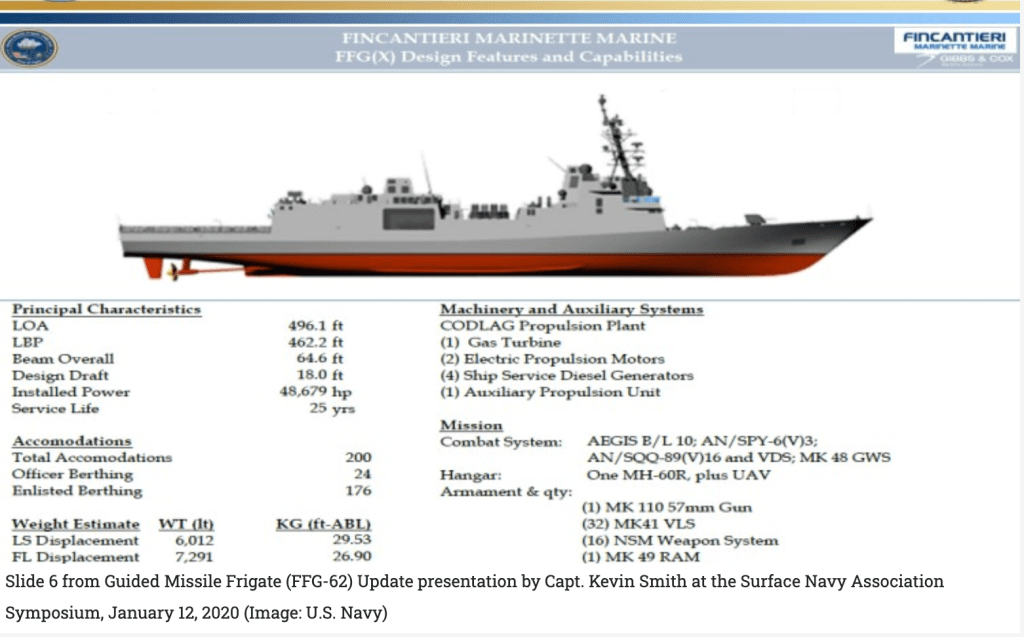

…but what’s striking, at least to this observer, is the frigate’s size as compared to its armament. The vessels are about 500 feet long and will displace something on the order of 7,000 tons – not all that much smaller than a Burke class destroyer – yet ship only 32 missile tubes, vs. 96 for the Burkes. Noteworthy as well is the absence of a hull-mounted sonar (though towed arrays, as discussed earlier, are increasingly capable at both active and passive searching, and the absence of something like the SQS-53C of the Burkes isn’t as serious as it once would have been). The ships won’t be cheap, either, with a unit cost projected at close to US $1.3 billion. Without knowing more, it’s mystifying why, at this size and price range, the Bath proposal wasn’t preferred. However, the decision is made, and the first unit should arrive sometime in 2026. Whatever one thinks of it, the modified FREMM is certainly a far, far better vessel than the weak, increasingly pathetic Littoral Combat Ships that were once touted as the US Navy’s small surface combatant solution.
Sub-surface Prowess
The present state-of-the art attack submarine in series production for the US Navy is the Virginia class, which began as a more economical follow-on to the ultra-capable Seawolf design, SSN-21, which proved too expensive in the post-Cold War environment to survive. The Virginias, while by no means cheap and cheerful, are indeed more economical to build than the Seawolfs, and are slowly becoming the backbone of the Navy’s undersea attack fleet, augmenting the advanced variant of the now venerable Los Angeles class boats that were superior to all comers back before the fall of the Soviet Union.
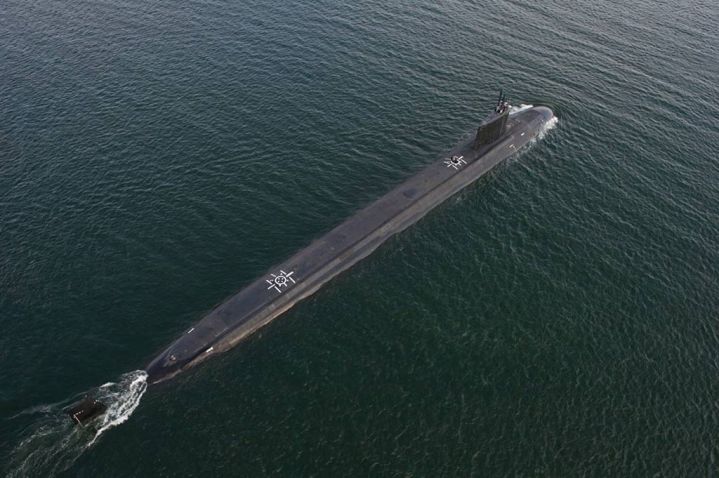
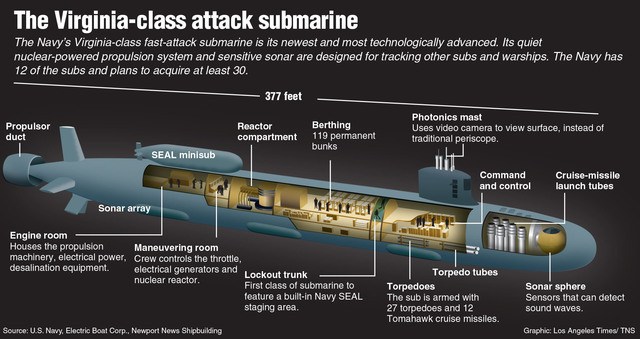
The Virginias are big for attack boats, topping out at close to 7500 tons submerged displacement, though smaller than the 9000 ton Seawolfs. They and the Seawolfs are still reckoned, for the time-being, as the quietest nuclear attack boats extant, though the much, much bigger (though not numerous – two so far, perhaps six more to come) Russian Yasen class is very close, and they have all manner of advanced sonar systems: their sonar suite includes a bow-mounted BQQ-10 active/passive array, wide aperture passive arrays on the flanks, high-frequency active arrays on keel and fin, a TB 16 towed array, and the Lockheed Martin TB-29A thin-line towed array. Beginning with the Block III series of submarines, the BQQ-10 sonar is replaced with the far more capable U-shaped Large Aperture Bow sonar. Finally, a high-frequency sonar array mounted on the sail and chin allows a Virginia to detect and avoid sea mines.

The Virginia class has four 533-millimetre (21 inch) torpedo tubes, capable of firing the Mk.48 Advanced Capability (ADCAP) heavyweight homing torpedo for use against surface ships and submarines, and the UGM-84 Sub-Harpoon anti-ship missile, which may soon reappear as a submarine weapon, based on the results of recent RIMPAC exercises. Early versions of the class carried twelve Tomahawk land-attack missiles in vertical launch tubes, replaced in Block III by two cylinder launchers carrying the same number of missiles. Block V Virginias, none of which is yet under construction, will expand the number of launchers to carry up to forty Tomahawks per submarine, via the new “Virginia payload module” inserted in an extension in the hull.
There is no doubt that the Virginia class comprises the most advanced and potent nuclear-powered attack submarines so far produced for any navy. Everything about them, from their fibre-optic “fly-by-wire” control systems to their “photonic” visual sensors (cameras and mast-mounted electro-optical sensors that replace the traditional periscopes of prior subs) screams high-tech, and the proposed Block V submarines are so advanced that it was once debated whether a proposed follow-on design contemplated for the mid-2030s was even necessary, a question that seems to have been resolved in the affirmative, with the latest planning documents indicating a renewed desire for a still more potent sub to be built beginning in the mid to late 2030s: Virginia Class Follow-on. The next generation, dubbed SSN-X, is starting to take shape in the form of a larger, wider sub closer in size to the Seawolf class, or perhaps even larger, and will probably leverage technologies now in development for the Columbia class ballistic missile submarines that are due to begin replacing the venerable Trident subs in the coming decades. God knows what they’ll cost.
It remains to be seen what these new technologies will be, or how the already very quiet Virginias can be surpassed by something still more acoustically stealthy. It’s a tall order. From the standpoint of detectability, the ducted pump-jet propulsors, anechoic hull tiles, and internal machinery isolation techniques incorporated into the class have taken them to the point at which there’s virtually no way to become substantially more stealthy without thinking up a new way of propelling vehicles through the water, one that doesn’t rely on rotating a drive shaft at all. Ideas along these lines do exist – for example, electric motors could drive propulsors directly, without shafts – but it seems to have become the consensus that something new and radical needs to be considered, given the evolving state of the art in Russian and Chinese sub design. In the mean time, incremental acoustic improvements of an undisclosed nature are being incorporated in the next batch of Virginias.
The primary anti-ship/anti-submarine weapon of all US subs remains the aforementioned Mk. 48 ADCAP (Advanced Capability) torpedo, a massive weapon that’s been in production since 1988, and kept up to date with continual improvements to guidance, propulsion, and sensors. The present version, first deployed in 2006, is the Mod.7 CBASS (Common Broadband Advanced Sonar System), weighing in at over 3,500 pounds, a whopping 650 pounds of which is warhead. The exact performance of the pump-jet powered Mk.48 remains classified, but it’s reputedly capable of speeds up to 55 knots, a range of 20+ miles, and a diving depth of 3,000 feet, making it more than capable of prosecuting any surface or sub-surface target now extant. The Navy is now pursuing a further upgrade to control, navigation, and sensors, for deployment in the late 2020s.


The current Mod.7 has both active and passive sonar sensors that are said to be astonishingly sensitive, able to detect and track even the quietest diesel-electric adversaries. While capable of autonomous operation, the Mod.7 also spools out fibre-optic cable through which guidance information can be communicated from the launching sub, and the new variant is also remarkably “brainy”, with “open architecture” computer systems that can be easily upgraded and reprogrammed – via laptop, no less – on board the boat.
There are comparable weapons out there, such as the UK’s Spearfish, and much ballyhoo surrounds the Russian “Shkval”, a rocket-propelled device that can reach speeds of over 200 knots underwater, but which lacks sensors, is unguided, has limited range, and is incredibly noisy, betraying the launching submarine; it would be madness to use it in most scenarios, and the thing would be almost useless in combatting something like a Virginia class sub. With the always-evolving Mk.48, US submarines seem likely to remain armed with the world’s most potent torpedo into the foreseeable future.
Expanding the Fleet – Unmanned Vessels and the “Ghost Fleet”
The success of the Sea Hunter program, discussed above, has spurred the development of further unmanned ships to undertake missions beyond anti-submarine patrol. Of particular interest is the Large Unmanned Surface Vessel, for which $400 million was allocated in the 2020 defence budget, which funded the purchase of two of the vessels for initial testing. Details are still somewhat sketchy, but the Navy intends for these ships to expand both the weapons and sensor capacity of the manned fleet, and the ships will be substantial, perhaps over 200 feet long, in the 3,000 ton class. The plan at present is to base the final design on an existing commercial hull, perhaps of the sort used for support of off-shore oil rigs, and convert it to mount vertical launch missile systems and associated sensors. This is the sort of vessel the Navy is looking at:

An artist’s concept of what the production models might look like:

If things go well, as many as ten such ships may be deployed by 2025. Preliminary work is well underway. In June 2021, details were released of long-range autonomous transit of a large USV named Nomad, which sailed from the Gulf Coast, made its own way through the Panama Canal, and travelled to the U.S. West coast. This followed on the heels of a similarly successful transit in 2020 by a vessel named Ranger. In September, 2021, the Navy released details of further tests involving Ranger, which was now seen mounting a canister for the firing of SM-6 missiles (the large, white, container-like box aft):

Smaller, medium-sized vessels are also in the works, and the effort extends beyond surface vessels. In 2019, a contract was awarded to Boeing for five Extra-Large Unmanned Underwater Vehicles (“XLUUVs”). Called “Orcas”, the new vessels are to be based on Boeing’s Echo Voyager technology demonstrator, an unmanned diesel-electric sub about 50 feet long, and displacing roughly 50 tons, which demonstrated an ability to operate autonomously over a range of roughly 6,500 nautical miles, which gave it the ability to operate independently for months at a time:


While slow, with a maximum speed of eight knots, Echo Voyager could dive to a phenomenal depth of 11,000 feet. Navigating by GPS when at or near the service, and inertially when diving deep, the little sub also mounts depth sensors and a satellite communications suite for keeping in touch with its home base. It’s anticipated that the follow-on Orcas will be capable of mine countermeasures, anti-submarine warfare, anti-surface warfare, electronic warfare (!), and strike missions, implying that the XLUUVs will be very much armed, and decidedly dangerous. Information released to date indicates that the Orcas will be more than 80 feet long, with a modular weapons bay capable of being configured for various specialized missions. This mine-laying concept, with the Orca carrying moored torpedoes to plant along the sea floor, was released in 2019:

The initiative to augment the fleet with unmanned warships has, with typical Pentagon verve for code names, been dubbed “Ghost Fleet Overlord”. This is a program to watch – in the coming decades it’s possible that unmanned vessels will compose a significant portion of the Navy’s surface and sub-surface fleets, acting as scouts, radar pickets, floating missile magazines (so-called “arsenal ships”, a promising concept dating back as far as the 1980s), anti-submarine watchdogs, and “attritable” forward deployed units that engage the enemy while precious units of the manned force remain out of harm’s way. Networked together, fleets of USVs could extend the intelligence gathering, targeting, and defensive horizons of surface action groups and carrier battle groups by hundreds, perhaps even thousands of miles.
These nifty Pentagon PowerPoint slides, extracted from a briefing by Captain Pete Small, Navy’s Program Manager of Unmanned Maritime Systens, lay out the “Systems Vision”:


Some further reading:
NOW, ON TO THE BAD NEWS
Despite a few bumps in the road, it’s possible to paint a rosy picture of the US Navy and its immediate prospects. Just look at all the hardware! Sure, there may be a certain amount of stumbling and bumbling in areas like naval gunnery, and many of the shiny new toys are being developed to address what are now glaring and dangerous shortfalls in capability, but still, the fleet seems well on its way to an entirely new level of combat effectiveness. With all the weapons and systems described above, something like a Burke DDG morphs from a humble, if highly competent, destroyer escort into a sort of pocket battle cruiser with a thousand mile radius of influence. Aided by coordinated swarms of stealthy drones operating under, on and above the sea, and communicating with a slew of manned aerial assets, individual ships could command vast swaths of ocean, and punch well above what used to be their weight class.
That’s the good news. Sadly, there is, as ever, bad news as well.
The Challenge
As the Americans strive to beef up naval forces, potential adversaries are doing the same. The world ocean is no longer an American lake. Rivals old and new are flexing their muscles in the blue water of the high seas.
Making a delayed but inevitable comeback are the Russians, who like to talk as if their fleet is fully resurgent, but still have a very long way to go before they can re-establish anything even approximating the naval power they deployed at the height of the Cold War. Their ship-building industry is known to be in a shambolic state, and their most impressive warships are badly in need of refit. A particular embarrassment was the most recent foray of the Kuznetsov, their sole aircraft carrier, to participate in the ongoing war in Syria. Belching huge columns of black smoke, and accompanied by an ocean-going tug to assist in case of breakdown, the Russian carrier deployed for only a short while, dumping aircraft into the sea and transferring the balance of its air wing to land bases, before retiring home for a major overhaul. In November 2018, the floating drydock in which she was resting sank under her, causing cranes to collapse onto the the flight deck. This might have seemed to doom further efforts, there being no other suitable facility, but the Russians continued on gamely, until the occurrence of the next setback in the form of a major fire, which did significant damage in December 2019. The usual rumours of graft and corruption have also attended the costly refit, and it was reported in 2021 that the shipyard director was arrested for absconding with about 45 million dollars allocated to repairs and upgrades.

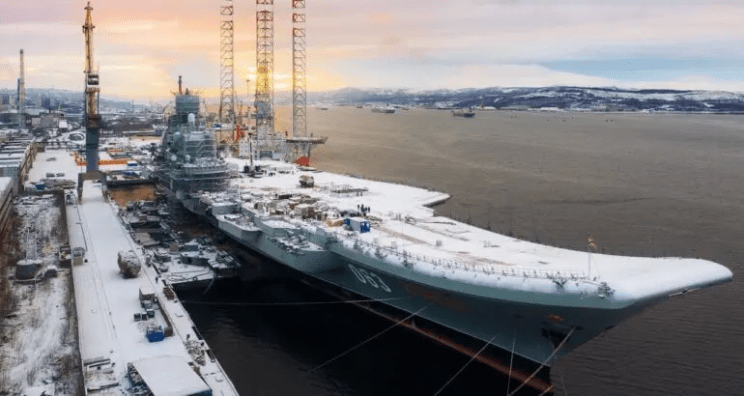
The latest official estimates have her going back to sea in late 2023. I’d bet against it, but who’d take that action?
Nevertheless, the Russians are no longer quite so risible as they were just a few years ago. Older but still impressive Soviet-era fleet units like the monstrous Kirov class battlecruisers Admiral Nakhimov and Pyotr Velikiy remain formidable capital ships. Nakhimov, in particular, is now undergoing an extensive modernization and refit, and is scheduled to re-emerge with updated systems, including the new Zircon hypersonic anti-ship missile, and a navalized version of the potent S-400 SAM system, in 2023, though the date keeps getting pushed, and the effort is obviously encountering both technical and financial challenges.

Other grandiose projects, like a nuclear-powered “destroyer leader” super-cruiser:

…and a proposed supercarrier:

…are trotted out now and then, but appear to be utter pipe dreams. Modernization of smaller Soviet-era fleet units continues however, like this example of the Udaloy class, Marshal Shaposhnikov:
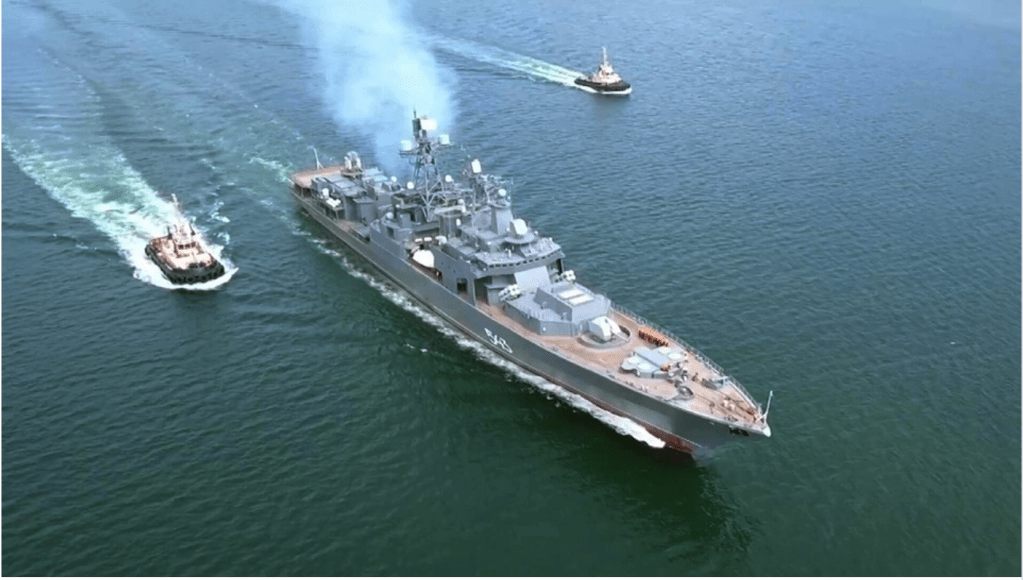
…and series production of smaller vessels, like the excellent frigates of the Gorshkov class, three of which are now at sea, with seven more planned to arrive by 2027, is proceeding apace. These really are fine, well-armed, well-equipped vessels, with typically impressive lines.


Still, the more daunting challenge comes from China. The Chinese have advanced their ship design capabilities by leaps and bounds, and now deploy 19 vessels that are described as “Aegis-like”, including 12 of the advanced Type 54D, a smaller rival to the US Navy’s Arleigh Burkes:
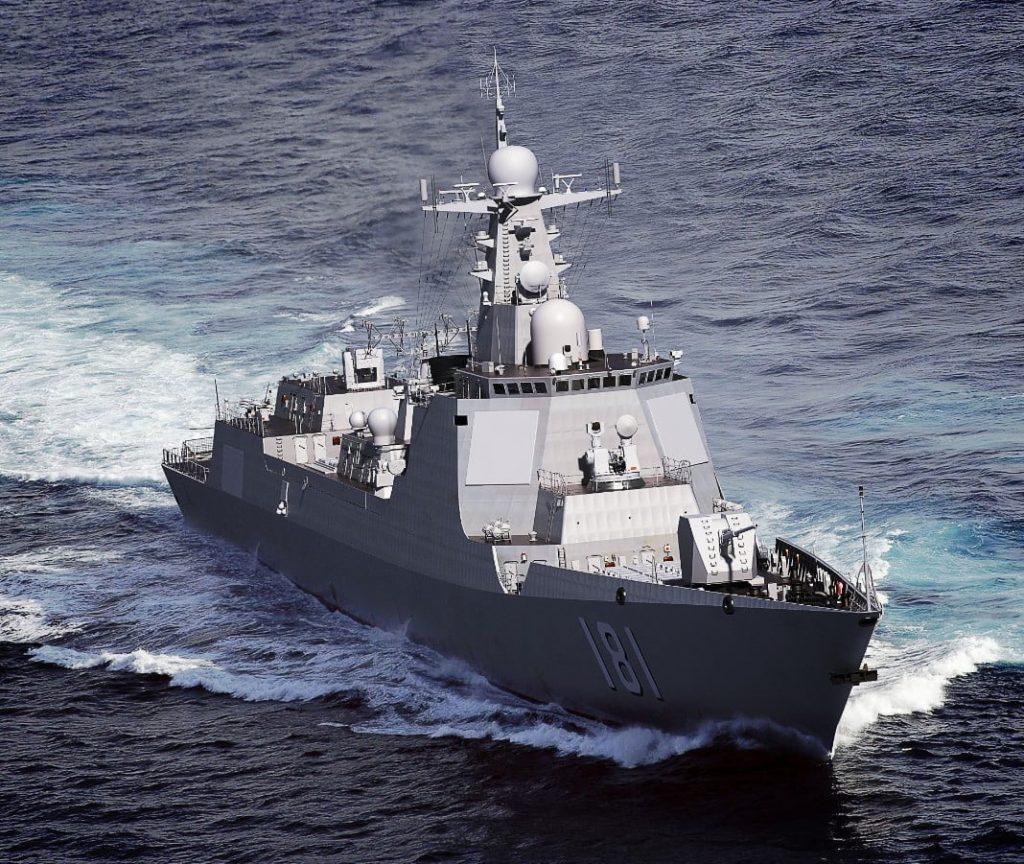
More threatening still is the new Type 55, a cruiser-sized ship boasting 112 vertical launch tubes according to the latest photographic evidence, an armament in the same league as the US Ticonderogas (which have 122). The first of these, the Nanchang, went to sea in 2020, and she and her sisters, of which at least seven more are now at various stages of construction and commissioning, may serve, like the Ticonderogas, as the air defence coordinators for carrier battle groups. This is a good representation of the final design:

This is the lead ship under construction, followed by a pair of images of the lead ship out on patrol, fully operational.
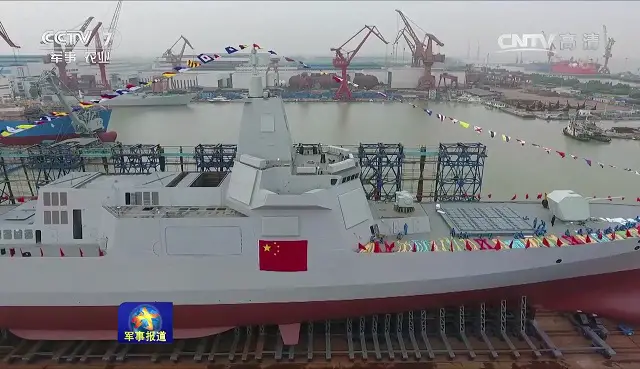
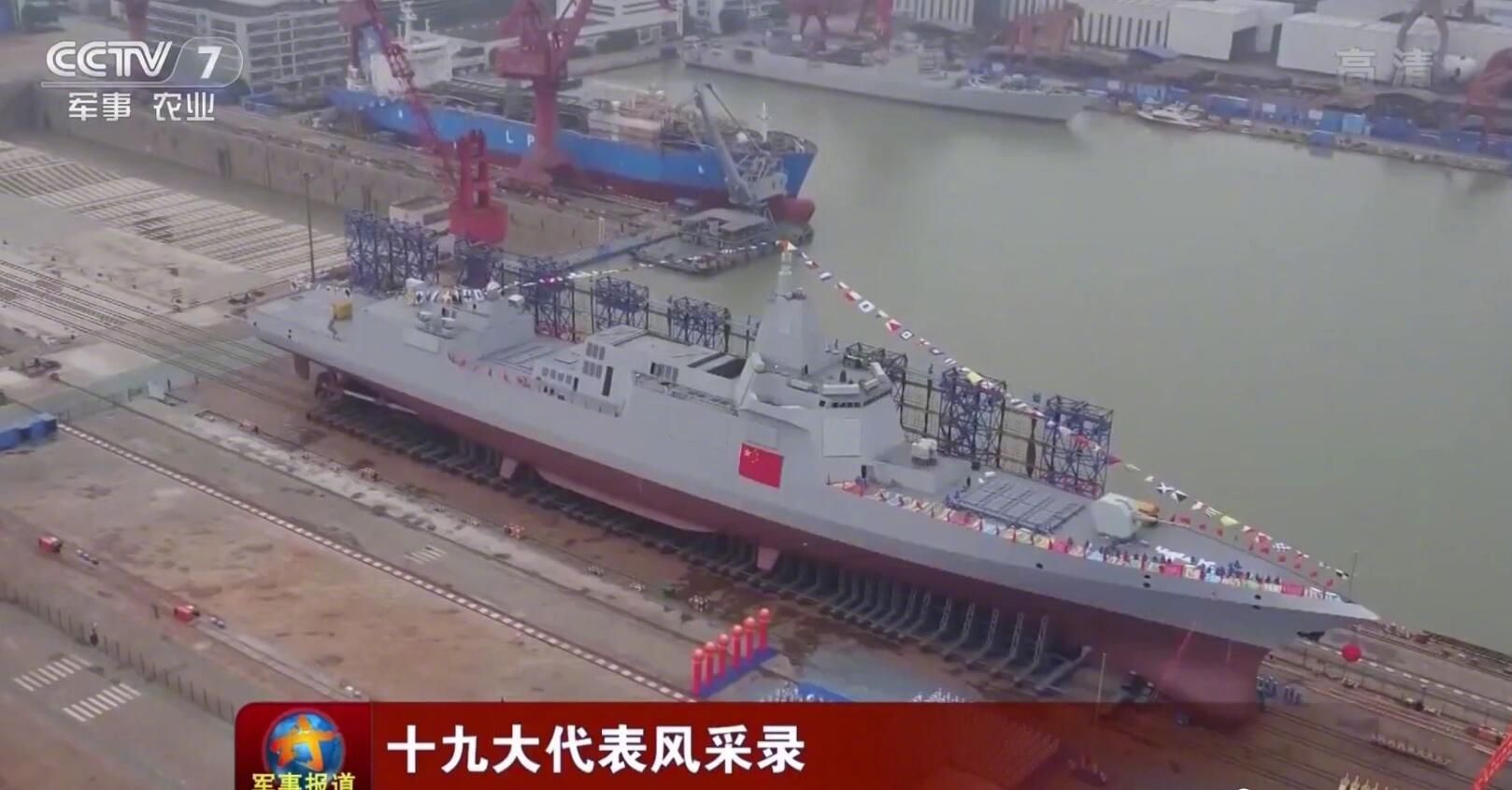


This is a thoroughly modern design, almost shockingly so, given what the People’s Liberation Army Navy was sending to sea only a few years back. It looks just like something they’d build at the Bath Iron Works, exactly the sort of vessel that should have emerged from the abortive CG(X) project. Shaped for a degree of stealth, and festooned with phased array radars and formidable VLS arrays (the cells of which seem quite a bit larger than their equivalents in the US Mk.41 system), the Type 55 would appear to be superior in some ways to anything now under construction in the West, save perhaps the larger and more radical Zumwalts, if those could be properly outfitted (which would only matter if more than three of them were built). The Flight III Burkes with their new AMDR sets may hold an edge in overall quality and capability of the electronics, but we have no way of knowing at this point, and by most other metrics the Type 55 is clearly a notch above the American destroyers; though classified as a destroyer by the Chinese, at 12,000+ tons it’s undeniably a cruiser, and a big one at that. In general terms it resembles the South Korean Sejong class, essentially enlarged Burkes with greater armament, the like of which one wishes the USN was now acquiring.
Meanwhile, the PLAN already has two carriers at sea, the Liaoning, a modernized unit of the Russian Kuznetsov class bought from Ukraine (originally under the guise of a project to equip her as a floating restaurant/hotel!), and the Shandong, a similar vessel built from scratch, and no doubt incorporating numerous lessons learned from the years of operating the first vessel:

Both are large, but by US standards comparatively modest vessels in the 65,000 ton class, carrying perhaps 40 aircraft. However, having completed their first home-built carrier, the Chinese are now moving rapidly to construct a new class, the Type 003, reputed to be in the same size class as American supercarriers, and sporting electromagnetic catapults, like those that are making so much trouble on the USS Ford, rather than the ski-jump systems of Liaoning and Shandong, which impose limitations on aircraft launch weights and therefore fuel and payloads. This is an initial impression of what the new carrier will look like:

Here she is under construction:

Here’s a side-by-side comparison with CVN-78 (Ford at top):

Only three catapults vs. four on the Ford, and only two elevators instead of three, but still, terrifying to contemplate.
Almost as bad, depending upon how seriously one interprets the meagre intelligence and uninformed internet chatter, the Chinese may now be further down the road towards a working rail gun than the US, based on images that have come to light picturing a ship outfitted with a very large and boxy turret mounted at the bows:
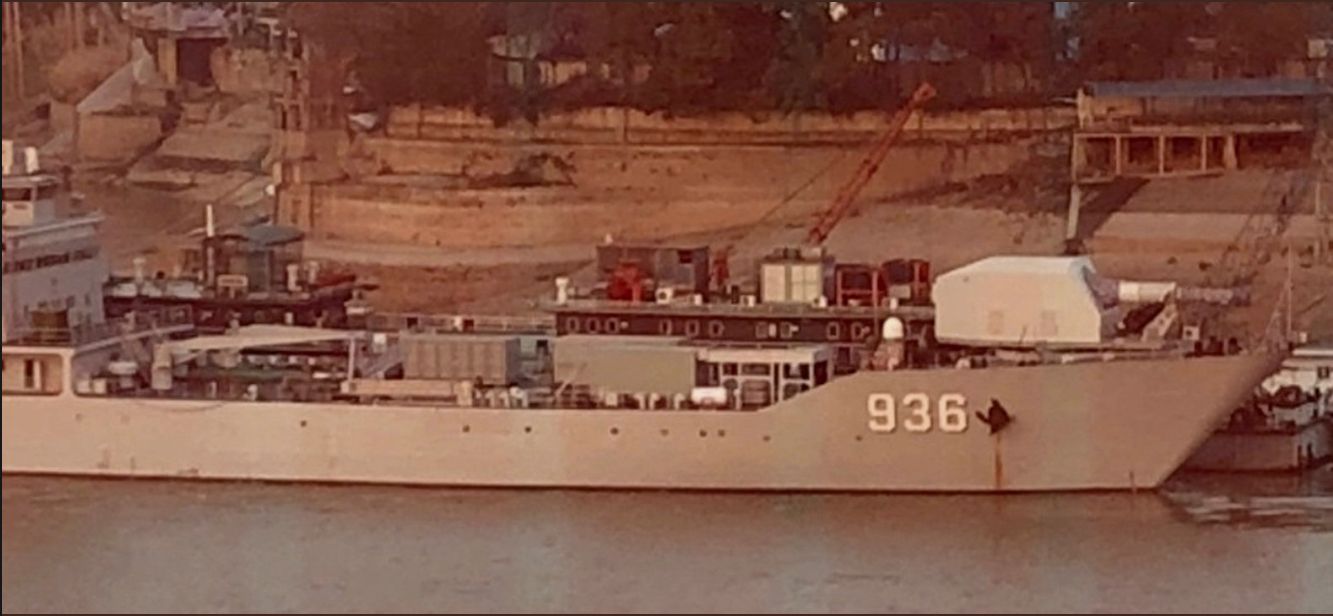

How awful, if this is for real, to have arrived at the point at which it’s no longer inconceivable that the PLAN would take a prototype of such a weapon to sea before the Americans. It’s predicted in some quarters that Chinese warships will be mounting operational versions of rail guns as early as 2025 – though, as with all such extrapolations, we’ll believe it when we see it. Some commentary derides this as little more than a PR exercise, asserting that China could no more have overcome the issues imposed by the relevant physics than the Americans have, and that rail guns, as it stands, are not practical weapons. It would be nice to think so, but one wonders.
The Chinese threat is in any case formidable, especially since China, unlike the United States (and despite recent joint exercises with the Russians in the Baltic) doesn’t need or aspire to a navy with responsibilities that span the entire globe. Local superiority over the Seventh Fleet in the South China Sea, and a solid presence in a few more distant areas of concern (perhaps the Persian Gulf or off the Horn of Africa), is the primary goal, and is starting to look eminently attainable.
Moreover, the Chinese are sending signals that they have every intention of flexing their new naval muscles to challenge one of the most fundamental tenets of the liberal world order, freedom of the seas. They seem quite serious in asserting that the South China Sea, through which literally trillions of dollars worth of international trade transit every year, should be recognized as China’s own property, all the way out to their farcical “nine dash line” that they’ve drawn on the basis of no laws or historical precedent.

They haven’t got a leg to stand on, legally, but what does that matter if they assert their specious claims by force, and nobody stops them? As if determined to snap their fingers under the noses of the Americans and the various interested nations in the neighborhood, the Chinese are effecting what’s starting to look like an annexation, through the construction of what amount to artificial militarized islands throughout the disputed seas. They’re building their new bases atop reefs and shallow areas like those that dot the Scarborough Shoals and Spratly Islands, which you can see on the map above.



Can they be serious? Do they really mean to militarize the South China Sea and present their effective ownership of this whole swath of the Pacific as a fait accompli? If so, let’s be clear: we cannot stand for it. We simply cannot. If the Chinese purport to control access to these waters we have to sail our warships through them, right under their noses, as often as possible and in overt and contemptuous indifference to their claims. If they try to muscle us out of there with their growing fleet, we have to push back with our own.
One can’t help but wonder how in God’s name we got here. It wasn’t all that long ago that a sort of Pax Americana reigned over the seas all over the globe. After the collapse of the Soviet Union, which saw the Russian fleet fall into decay and disarray, it wasn’t immediately obvious who might pose a challenge to US naval dominance in the forseeable future. In the absence of any contenders in the blue water of the open ocean, US naval planners started thinking about brown water “littoral” operations and power projection ashore (hence the Zumwalt class, outfitted for shore bombardment, and the Littoral Combat Ships, meant to be optimized for low intensity brown water operations). Those were the days.
All of a sudden, the traditional threat is back. Different opposing team, same game. To push back as emphatically as we may have to, we’ll need a larger fleet than the one we have, especially in the vast Pacific theatre.
Order of Battle – 355 Ships? Or what?
As the fleets of potential foes grow by leaps and bounds, the US Navy has become uncomfortably small. Until recently, plans had the fleet expanding slowly towards 308 ships of all types, including 11 carrier battle groups, but during the Trump administration the goal was raised to 355, a Navy aspiration now being reconsidered, if not fully abandoned, but one the details of which bear further examination, as a way of illuminating the challenges involved.
To begin with, it’s important to maintain some perspective on the over-stretched, vessel-starved state of the United States Navy. At present there are still 22 Ticonderoga class cruisers, and the Senate Armed Services Committee has repeatedly pushed the Navy to modernize all of them, and keep them all at sea – more on that below. Counting only vessels already under construction or subject to established contracts, by 2024 there will be 77 – seventy-seven – DDGs of the Arleigh Burke class, still the epitome of their kind. Among these, the first two ships of the next batch, “Flight III”, fitted with the above-described AMDR, are already under construction, with many more to come; a multi-year procurement contract for 10 more was announced in October 2018.
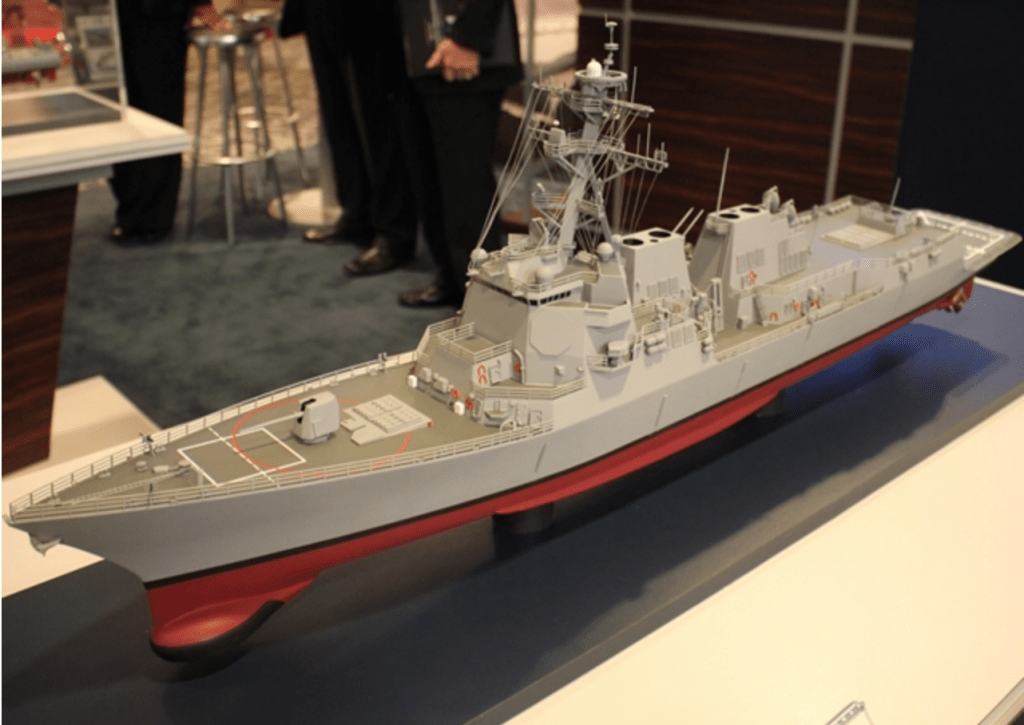
Thus even if half the Ticonderogas are soon paid off, we’re still, potentially, talking about 90+ ultra-sophisticated Aegis vessels, armed to the teeth, perhaps closer to 100 by the end of the next decade, retirements permitting (see subsequent discussion) – about twice the combined total of all comparable warships operated by all other navies on Earth, most of which are in any case friendly. And don’t let’s forget those friends. Australia and South Korea are building highly capable little fleets with their own Aegis vessels, and Japan is a major naval power that on its own still rivals China in maritime strength. The Royal Navy has built two genuine super-carriers of the Queen Elizabeth class, plus the highly advanced destroyer escorts to protect them, and HMS Queen Elizabeth has lately been on deployment in the South China Sea. The Dutch, Italians, Germans, even the Spanish and soon, we are told, Canada, all do or will operate sophisticated naval forces with Aegis or comparable technologies. The French, with their nuclear carrier Charles de Gaulle, are increasingly willing to pitch in.
The Indians, if not allies, are certainly not hostile, and no friends to China. There are signs they may draw closer to the USN in the next few years. Their navy includes a modern aircraft carrier, and another two on the way, one of which may be in the size class of the Nimitz and its super-carrier kin. The Indians also operate some rather formidable destroyers. Indian ships carry one of the most frightening anti-ship missiles extant, the “Brahmos”, that sea skims at over Mach 2.5. China has to reckon with them, too.
The thoroughly modern, highly potent warships pictured below are not American; they are Japanese, South Korean and Australian, staunch allies all.
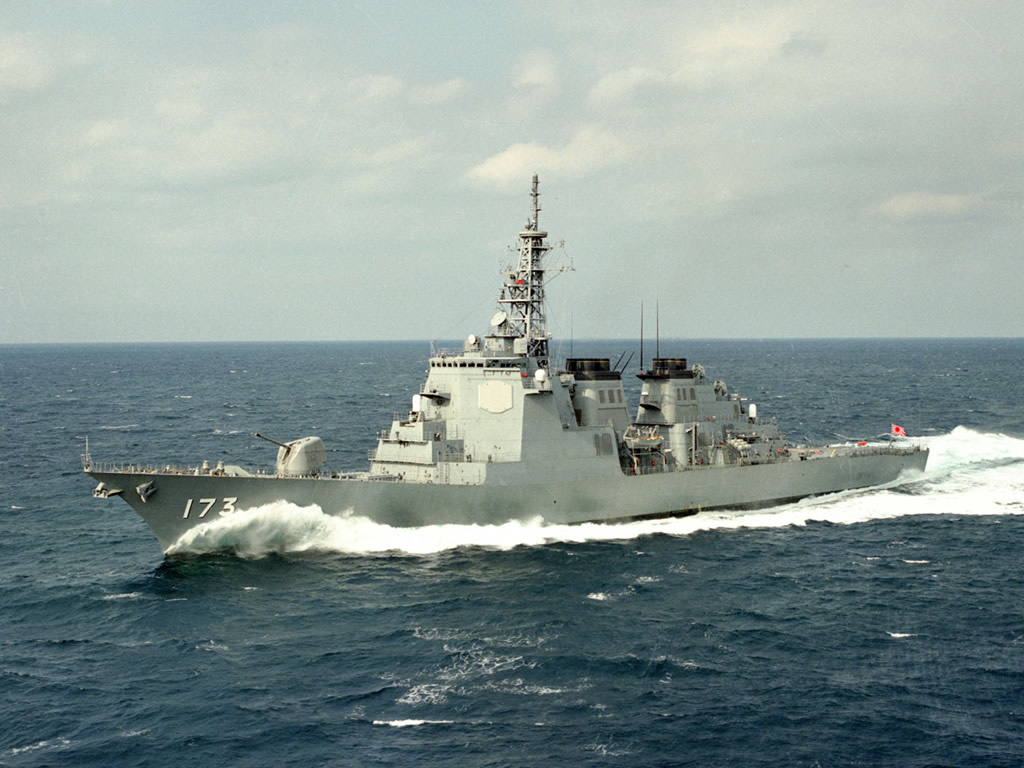


Remember, too, that while we talk about 11 American aircraft carriers, all of the large air capable assault vessels, brutish 45,000 ton slabs of steel that any other nation would be happy to call capital ships, could be fitted out to operate Joint Strike Fighters, much as they already operate Harriers. Realistically, America in the next few years might deploy not 11, but more like 20 or 21 carrier battle groups.
Bear in mind: the ships pictured below are not, to the Americans, “aircraft carriers”.


If you line up all the carriers operated by, or under construction for, all the world’s navies, you get the (somewhat out of date, but still generally accurate) result pictured below.
We have challengers on the open ocean, yes. But based on a chart like this, one might be tempted to ask: which side would you rather be on?
Of course, such gross comparisons are overly simplistic, and while it’s possible to get a little too gloomy about the state of U.S. sea power, it still has to be admitted that the current U.S. Navy is too small, and would still be too small if it grew according to the original plan to 308 ships. It’s not just about how many ships you can deploy, but how many you can deploy to any one point, and whether the foe at each of those points will have enough ships to maintain local superiority. Eleven carrier battle groups may be more than any other nation, but that won’t be enough to cow China if the US Navy can spare only four of them for operations in the South China Sea, where the PLAN can surge six.
It’s also the case that as the Navy spreads itself thin over several theatres around the globe, too many low-end missions are being performed by high-end ships – you don’t need a two billion dollar Aegis destroyer to take the steam out of pirates in motorboats. This is one area where the Littoral Combat Ships might actually prove useful, but large numbers of new and better frigates, able to maintain a credible presence in regions where the threat is a little greater than off the horn of Africa, can’t come quickly enough.
It’s obvious that a new surge of ship construction is necessary, and the drive toward a force level of something on the order of 355 ships makes all the sense in the world. The problem is that the money and shipbuilding capacity required for such an expansion seem not to exist.
This is especially the case because simply building more ships won’t necessarily add to the size of the fleet – naturally, it’s not going to be as simple as all that. The roster has to expand at a rate that exceeds the pace of retirements, at a time when the trend is actually towards a shrinkage in fleet size. One obvious measure would be to arrest the decline in numbers by funding extensive modernization of the ships that exist, extending their service lives, but this has turned out to be easier said than done.
The status of the Ticonderoga class Aegis cruisers presents the larger problem in perfect microcosm. The first five ships of the class, including the Ticonderoga herself, were decommissioned years ago, it seeming too expensive and difficult to upgrade them from the original rail-arm Mk.26 missile launchers to the Mk.41 VLS system, which first appeared on the Bunker Hill, CG-52. The 22 remaining cruisers have been dealt with in a rather haphazard process, as Congress has tussled repeatedly with the Admirals over how to go about modernizing the ships and keeping as many as possible in the fleet. The Navy has lobbied repeatedly to take 11 hulls out of action to be slowly (but thoroughly) modernized, while the remaining 11, enough to supply one to each carrier battle group, would continue to serve until they were worn out. As each of the active ships was used up and retired, a modernized one would come out of refit to replace it.
This sounded fine, but Congress was always suspicious of the scheme, worrying that the Navy would never really put the decommissioned ships back into action. The eventual compromise was a mandate from Congress to engage in a “2/4/6” program of upgrades; rather than take a block of 11 ships out of commission, two would be sent into modernization each year, so long as no more than four cruisers were being refitted at the same time, and no single refit took longer than six years. The implementation of the scheme is still being debated.
As the bickering drags on, the service life of the entire class is coming to an end. Over the years some of the ships have received structural and electronic upgrades, and 11 have received extensive electronic improvements, including the installation of “open architecture” systems and an upgrade of the Aegis system to Baseline 9, which supplies a capability for ballistic missile defence, but this does nothing to address the more fundamental problem: the very structures and physical systems of the vessels are reaching their limits. The computers that run them may be state of the art, but the radars are still the original SPY-1A/B PESA arrays, a little old and cranky. There are cracks in the aluminum superstructures, and many ships have hull integrity issues that arise in part from the effects of ballast that had to be added when the first units – which represented about the maximum volume of systems and electronics that could be crammed into the basic Spruance class destroyer hull – proved a little top-heavy.
As it stands, the Navy is proposing to begin retirements in 2022, with six or seven cruisers leaving the fleet – reports are that the Admirals have selected Bunker Hill, Mobile Bay, Antietam, Leyte Gulf, San Jacinto and Lake Champlain to get the chop first, though it isn’t yet clear that Congress will go along with it. If the Navy gets its way, how many of the remaining 15 will still be at sea in another six or seven years, and what their state of modernization will be, is anyone’s guess at the moment. The obvious alternative, of course, is to build a new class of ship, but in the new funding environment in Congress, as the Biden administration tussles with its own party over an ambitious “Build Back Better” human infrastructure plan slated to cost trillions of dollars, while deficits continue to increase and the Republicans continue to play extortionate games with the debt ceiling, talk of a new cruiser, recently revived, has to be taken with a grain of salt. Near the end of the Trump administration, concepts were floated that sound a lot like the CG-(X) design that was abandoned over 10 years ago owing of cost:
Meanwhile, the Navy seems less than enthused with cruisers, especially when it comes to the current stock, with current Chief of Naval Operations, Admiral Michael Gilday, indicating that he’d prefer to stop ploughing money into the Ticonderogas and build more, smaller hulls as part of the new Navy vision of “distributed lethality”:
Does it make more sense to hang on with the cruises that are that are well past their 30-years service life, continue to pour millions of dollars into upkeeping those vessels, [while] the White House has directed that we divest of legacy and invest in new platforms? For the Navy, we know that’s a distributed maritime operations concept that is driving a smaller, more distributed fleet [with fewer] large vessels, and more lethal, smaller vessel. That means frigates. So we should have that debate over whether we should put that next dollar into a 33-year-old cruiser, or whether we should invest in the Flight III DDG.
The debate continues. Officially, a new large surface combatant, dubbed “DDG-X”, remains in the planning phase, with $121.8 million in research and development funding for the program included in the Navy’s proposed FY2022 budget requests. Lead ship of the new class is projected for 2028, about when the last of the most recent tranche of Flight III Arleigh Burkes is delivered, but what form the new vessel will take, or even if it will be bought at all, remains very much up in the air. It’s been proposed that a simple answer would be to build more Burkes, further improved, based on the Flight III design, but the growth potential of the venerable design is all but exhausted at this point, particularly when it comes to the installation of more electrical generating capacity to feed the directed energy weapons that are thought likely to become an important part of any new warship class’s armament:
The much larger Zumwalt class would probably provide a better basis for moving forward, albeit perhaps at even greater expense. It’s hard to say whether series production would bring down the exorbitant unit cost experienced over the limited build of just three hulls, when economies of scale are balanced against the added costs of the much more elaborate weapons systems that a proper Ticonderoga-style battle group air defence coordinator should mount. The options are discussed more thoroughly in this Congressional briefing paper:
https://crsreports.congress.gov/product/pdf/IF/IF11679
I’m not optimistic, even though the program seems thus far to remain alive and well. On January 12, 2022, preliminary details were revealed on the sort of concept being pursued, via the release of a PowerPoint presentation authored by one Captain David Hart, DDG-X Program Director. The idea is to build a new warship around the Aegis Baseline 10 / SPY-6 architecture developed for the Flight III Arleigh Burkes, with an emphasis on directed energy weapons and hypersonic missiles:
https://breakingdefense.com/2022/01/navy-unveils-latest-concept-for-future-destroyer-ddgx/


The hope is to jump to lasers in the 600 kilowatt range, vs. the 100-150 kilowatts on the devices currently deployed, the power demands of which will be met by the same sort of integrated electric propulsion system designed for the Zumwalt class stealth destroyers. Plans are to begin construction as early as 2028, though details on size, armament, and even basic hull form are very much up in the air at present (or “pre-decisional” as the presentation puts it), though it looks as if the radical “tumblehome” hull of the Zumwalts has been rejected. We’ll see.
Whatever the fate of DDG-X, the question remains: how can the fleet expand dramatically when its existing ships, including its most powerful and vital AAW assets, are steadily being written off? Achieving the former 355 ship target would have required a net increase of 50 units over current numbers, even as the current ships steadily disappear. Who’s going to build complicated and expensive modern warships at such a prodigious rate? These days there are only three major shipbuilders to participate in the process – General Dynamics, Huntington Ingalls, and Lockheed Martin – and there are only three really major shipyards fit to produce large surface combatants – the Ingalls facility in Pascagoula Mississippi, the legendary Bath Iron Works in Maine, and the equally famous Newport News facility at Norfolk, Virginia, the only yard on earth that can manufacture the huge nuclear-powered supercarriers that have formed the backbone of US Naval might for decades. Nuclear subs are also put together at Newport News, and at the Electric Boat yard in Groton, Connecticut, and there are a couple of yards involved in the construction of the much-maligned littoral combat ships. One of those, the Marinette Marine shipyard in Wisconsin, will be used to build the new Constellation class frigates.
So much for raw capability; what about money? The financing of all aspects of the U.S. Government remains a mess in the profoundly dysfunctional Congress. Recall how, in 2018 the US Government, having flirted with a shut-down, at last agreed to a new budget deal. The new spending regime increased military spending, but all the euphoria surrounding that good news tended to ignore that the deal extended only for two years, until 2020. Now they’re back at it, with the Republicans indicating for most of 2021 that they’d do absolutely nothing, under any circumstances, to help the Democrats pass any sort of budget, and were even playing games – again – with the debt ceiling. As 2021 drew to a close, crisis had been averted, yet again, and a new defence appropriations bill had landed on the President’s desk, but it’s always a struggle, and seems like it always will be. Even if those problems can be resolved, and the required years of steady, predictable funding can be secured in a manner that allows for the long lead-time spending necessary when building major warships, the US shipbuilding industry would still need to be firing on all cylinders to get to something like 355 ships.
It’s possible that in a stable funding environment, new entrants could be coaxed into joining the military shipbuilding effort. Efficiencies arising from larger production runs could also be exploited. By varying the underlying assumptions, the Congressional Budget Office has gamed out fast-track scenarios that might make the 355 ship objective attainable in as few as 15 years, but those seem mired in the realm of fantasy given the petty, nay childish, politics that Congress can’t seem to transcend these days. Even getting there in 30 years would, by CBO estimates, require an annual increase in shipbuilding funds to the tune of 27 billion dollars. Given the retirements that will also occur, fully 329 ships would need to be constructed over the next three decades to wind up with 355 in the water come 2048. Manning those ships would require 19,000 extra sailors, out of a combined total of 48,000 additional personnel, both civilian and military, and 15 billion more dollars per year would have to be spent to buy the aircraft to keep the current and additional carrier decks populated. Annual operational costs would rise from 38 billion to 56 billion, in 2017 dollars.
How likely does all that sound?
Well, not terribly, as it turns out. The most recent long range shipbuilding plan steps back from the 355 target, while not outright abandoning the possibility, emphasizing distributed lethality instead of raw numbers, and projecting a future manned fleet of as few as 321, but perhaps as many as 372 manned ships, depending on the breaks. The lower end of this range may seem more palatable given the rise of unmanned vessels, which the Navy now anticipates might number anywhere from 77 to 140 units. Here’s the key table from the latest 30-year plan submitted to Congress:

Read more here:
Even if this latest plan is feasible, getting to the projected force levels sometime around 2048-2050 sounds wholly unsatisfactory. The Navy needs ships now. Hindsight is 20/20, but finding the hulls in the short-run might have been easier if the Brass hadn’t been so keen to dispose of older units, rather than put them into proper storage. For example, there used to be over fifty FFGs of the Oliver Hazard Perry class; many of them had only 20 years or so of service when they were decommissioned, and then sold to foreign fleets, or used as targets.
Even worse was the disposal of all 31 ships of the Spruance class, large destroyers with big, roomy, modular hulls that displaced 8000 tons, lending them loads of room for new systems. These were modern warships powered by gas turbines, easily capable of the 30+ knot speeds needed to keep up with carrier battle groups. They were also, frustratingly in light of recent developments, superb ASW destroyers, with two helicopters and essentially the same sonar suite boasted by the Burkes and Ticonderogas. Over the years, they went from being rather under-armed to become the most powerful destroyers in the fleet, with a 61 round VLS forward, usually packed with cruise missiles, and room for another such VLS array aft if needed – remember, the mighty Ticonderogas that boast this dual VLS layout were built on the same hull. Most of them had served between 20 and 25 years when they were retired, and had they been preserved for future contingencies they could now be re-entering service in upgraded form, with more than a decade of useful life still left. Instead, they were shot to pieces in SinkEx exercises. SinkEx exercises. Target practice. A crying shame, it was. Just look at USS Fife, a typical member of the breed, pictured here in better days:
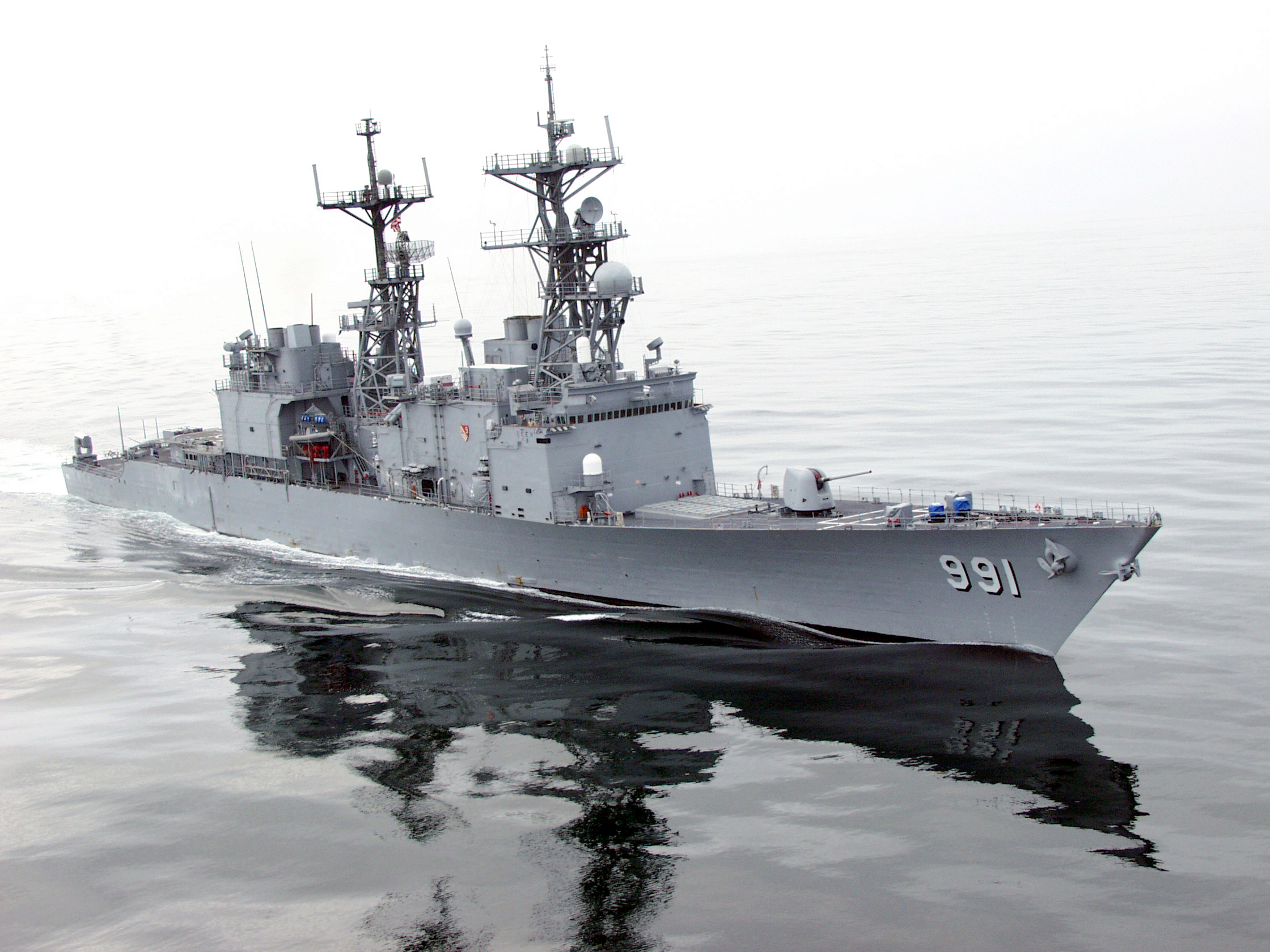
Pretty, isn’t she?
Here’s what they did to her:

Here’s one of her sisters meeting a similar fate:

They didn’t even salvage the 5 inch guns.
Just to rub salt in it, here goes one of the early Aegis cruisers, the Valley Forge:

She was decommissioned after only 18 years of service.
Let’s not even get into the four ships of the Kidd class, powerful DDGs also based on the Spruance hull, now serving the Taiwanese Navy.

The Navy would argue that these older hulls would have proved too expensive to modernize for combat in the 21st century, even had they been carefully mothballed for possible return to the fleet. They’re saying the same thing now about the few Oliver Hazard Perry FFGs that remain in storage. Yeah, well, maybe. I doubt it. I think they prefer to lobby for shiny new ships, and viewed the older units, however much useful life they had left, as threats to their plans. It’s an old story in military procurement; the armed services reject the modernization of existing weapons systems with the aim of acquiring new ones instead, and end up getting neither.
Is this too cynical? It is true that much of what’s gone on over the past 20 years can be attributed to the aim of ensuring that virtually all surface combatants are Aegis-equipped, and no bias against updating older units to keep them at sea was discernible in the Navy’s plans, now up in the air, to extend the service lives of all vessels of the Burke class to 45 years:
But you don’t need a fleet composed exclusively of warships suited to the highest high-end combat. The Navy understands this, or it wouldn’t have launched the Littoral Combat Ship Program.
This page from the CBO provides a great overview of the challenges inherent in any ambitious fleet expansion:
https://www.cbo.gov/publication/54564
Yes, the latest proposals do indicate that some still think an expansion to at least 320 ships, and perhaps as many as 370, remains possible, over the long haul, and yes, unmanned vessels will also add numbers and are probably the wave of the future, though getting to an appropriate force level that way feels a little like cooking the books. Taking a step back, it’s disheartening, and a little bit incredible, that expanding the manned fleet to an appropriate level within any sort of reasonable time frame may be beyond the capacity of the United States. It shouldn’t have been allowed to get this way.
Reaching the Limits of Endurance?
Why 355 ships, exactly – where did that number come from? Reportedly, it arises from a sort of back-of-the-envelope calculation as to how many vessels are needed in commission to maintain a force of about 100 forward deployed at all times, as required to fulfill all of the Navy’s operational commitments around the globe. The rule of thumb is that to maintain a sensible and sustainable pace of operations, for every ship deployed there need to be three others that aren’t, one undergoing maintenance, one engaged in training, and one in transit. By this reckoning, 355 ships would be, at best, a bare minimum to keep 100 out on station at all times; actual needs point to a requirement for something closer to 440-450 ships (still well below Cold War levels). At this force level, the navy reports that it can meet only about half of the force requests it receives from theatre commanders around the globe.
With the 300 or so ships now available, the Navy must struggle to meet its commitments, certainly deploying no more than 100 ships at a time (by some reports 50 is sometimes more like it, with 25 more at sea “underway”, presumably in transit), as its ships and personnel tough it out through a grinding tempo of operations that simply can’t be sustained in the long run. The risks in burning the candle at both ends became painfully obvious in 2017, when two Burke class destroyers, the McCain and the Fitzgerald, were involved in collisions that took the lives of 17 sailors. To those of us in the lay public, the nature of these accidents seemed almost impossible to believe – how does a ship equipped with that level of systems and navigational aids, not to mention the usual personnel on watch, manage to collide with massive civilian transports while navigating in relatively calm seas and ordinary weather? They can track satellites in space, but miss a 50,000 ton freighter? True, the sea lanes near Japan and Singapore, where the accidents occurred, are crowded, and it can sometimes get a little tricky to keep a safe distance from all the surrounding traffic, but surely this is a challenge well within the capabilities of >billion dollar Aegis destroyers.
Crews that are tired and overworked, out on deployment too long, too often, frequently at the expense of training time, make awful mistakes. It really does seem to be as simple as that. The point arrives at which a “death spiral” becomes possible, as routine maintenance is deferred and overworked ships and crews simply wear out, or suffer accidents, decreasing the size of the fleet and putting more pressure on the remainder, which are then even more prone to exhaustion and mishap. Unless more resources are committed to the Navy, fast, we’re always at risk to see more disheartening scenes like this:

It isn’t just the sailors who are wearing out, of course, and shortfalls in shipyard repair capacity have led to a dangerous maintenance backlog which the Navy is now scrambling to address. In 2017 the GAO reported that there was five billion dollars worth of deferred repair and refurbishment that needed to be addressed. A $20 billion program is now underway to improve shipyard capacity, but it may take as long as 20 years to complete, and that assumes a stable budget environment. Meanwhile, the ships now in service continue on a punishing schedule of deployments, which has them out to sea for several months at a time, only to return looking beat-up and about to keel over, as was made all too public by a set of images that went viral in the first half of 2021, much to the embarrassment of Navy brass. Here’s USS Stoat returning to port after 215 consecutive days at sea:

It’s not uncommon for ships to look like this while sitting in port, prior to deployment:

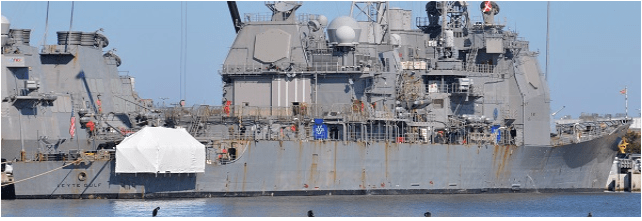
Too, the general impression of the state of the Navy’s maintenance/repair/modernization efforts wasn’t much enhanced by the spectacle of the destruction of the multi-billion dollar Wasp-class LHD Bonhomme Richard, which was undergoing extensive maintenance in San Diego when a fire broke out on a lower deck, which then spread to thoroughly gut the entirety of the ship’s interior, and all but burned the island superstructure down to deck level. When the conflagration was finally brought under control, inspections revealed so much damage that repairs were reckoned to require over three billion dollars and perhaps seven years of yard time, making it a better option to sell what was left for scrap. Here’s what’s left of her, being towed away to the breakers:

The Navy is charging a sailor with arson, which isn’t the same thing as general negligence, but isn’t a great alternative explanation for the loss of such a significant and expensive fleet unit.
Nevertheless, progress is, reportedly, being made. Between the years 2014 to 2019, about 75% of ships that entered a maintenance yard stayed there longer than planned, with more than half of the delays lasting longer than 90 days. Reports from the General Accounting Office cited both insufficient capacity at the Navy’s shipyards and skilled labour shortfalls, problems which Naval Sea Systems Command (NAVSEA), the responsible organization, has struggled mightily to redress. In 2020, officials at NAVSEA announced that the total number of days by which ships overran their planned maintenance schedules fell by 80% compared to the previous year, from a collective 7,000 days of delays across the fleet in 2019 to about 1,100. Thousands of new personnel have been hired, and training accelerated, though both efforts have recently had to buck the headwinds of the COVID pandemic. The hope is to eventually bring delays down to zero, or as near that as the laws of physics and complex systems permit, which would, given the circumstances of prior years, seem little short of miraculous.
Such won’t, however, cure the problem of too few ships fulfilling too many missions.
As Above, So Below – The Submarine Shortage
Back in those heady Reagan-era days of John Lehman’s 600 ship Navy, the goal was 100 nuclear attack subs, a number that was never quite reached, but almost. In those days the force still included the old Skipjacks, the Permits, and the Sturgeons, and coming on line in large numbers were the units of the very potent Los Angeles class, series constructed to an eventual total of 62 boats, 35 of which are still in service. The follow-on was supposed to be the Seawolf class, huge, magnificent artifacts of the waning days of the Cold War, which were as capable as they were expensive, at 3 billion a unit (in 1995 dollars!); at that price, given the collapse of the Soviet Union, only three were built. A smaller, less expensive, but still highly capable design was pursued, leading to the Virginias (SSN-744 and up), which are now becoming the backbone of the SSN force, slowly replacing the remaining Los Angeles class boats. The Virginias were supposed to be dramatically less expensive than the Seawolfs, about 1 billion cheaper, and while as time has gone on the price has crept up, in the way of these things, with the latest iteration of the Block Vs budgeted to cost over 3 billion each, this is still only about 1.8 billion in 1995 dollars – so, mission accomplished. The problem is numbers – only 17 are now in service, one more is close, and a follow-on batch of 10 more is building right now for delivery in the 2019-2022 period, with more planned, but as the remaining Los Angeles class subs are retired, this leaves America with a dire shortage of fast attack boats.
Today’s problems stem from the complacency of the post-Cold War environment. In the early 1990s America possessed what appeared to be a surplus of attack boats, given the far less threatening global geopolitical environment, and the Navy took what amounted to a holiday from building new submarines. Only a relative handful of boats were built, while at the same time the old units of the Skipjack, Permit and Sturgeon classes were all retired – the unforgiving stresses of the underwater environment impose an upper fatigue limit on the service of lives of submarines, which can’t be stretched in the same way that’s possible for surface ships, even if such had been desired – and in the late 1990s and early 2000s, the retirement of the older units of the Los Angeles class also, perforce, began. The result was not only a dramatic drop in the number of active submarines in the fleet, but also in the industrial base that builds those vessels.
This has left the Navy with only 52 attack boats, four more than the stated requirement as it stands, but far too few to meet the challenges presented by a rising China and a resurgent Russia. The Navy is now thinking that at least 66 boats are going to be needed. Clearly, the pace of construction needs to be accelerated, but with the yards available – Newport News in Norfolk, Virginia, and the Electric Boat Division in Groton, Connecticut are it – it’s hard to imagine proceeding at a rate higher than two boats a year, especially since the next two decades will bring the need to replace the Trident SSBNS of the Ohio class, the mainstays of America’s nuclear deterrent.
Current projections, given present industrial capacity, have the attack boat force dropping to a low of 41 units by the 2030s. This is wholly unacceptable. If Electric Boat can handle the entire Ohio replacement program, Newport News may be able to build two Virginia class subs at a time, rather than one, but this will require increased and stable budgeting, and even at that the US Navy is not likely to get above 45 to 50 SSNs any time in the next few decades.
So far the Navy has shown absolutely no interest in buttressing numbers with purchases from foreign sources, such as Japan, Sweden, or Germany, all of whom produce increasingly potent, and much smaller and more economical, diesel-electric submarines. As discussed, modern examples of non-nuclear subs are being produced with “air independent propulsion” systems that allow them to remain submerged for weeks at a time, approximating the capabilities of nuclear-powered subs, and they’re extremely quiet when running submerged. The author’s view is that the Navy’s “all nuclear, all domestic” policy needs to be revisited. The submarine force projected over the next few decades simply doesn’t cut the mustard.
The Wild Card: Hypersonic Cruise Missiles
A new weapon may be in the offing that could change the balance of power at sea and have a dramatic effect upon the viability of large surface combatants: the hypersonic cruise missile. It will soon be within the technological grasp of Russia, China, America, and heaven knows how many others to field guided anti-ship missiles that operate within the atmosphere at speeds above Mach 5, that is, at a clip at or exceeding a mile per second. These may be air-launched, or even strapped to the top of ballistic missiles, in a “boost-glide” package that takes the weapons to high altitude, out to the edge of the atmosphere, before releasing them to plunge at ungodly speeds toward their targets. Artists’ concepts generally portray these missiles thusly:

That’s actually an artist’s rendering of the X-51 Waverider, an experimental US hypersonic that achieved speeds of over Mach 5 in tests conducted in 2013.
The Russians claim to have one such weapon on the cusp of deployment, the “Tsirkon” (Westernized as “Zircon”), for which speeds as high as Mach 8 have been reported (dubiously); supposedly, these will be operational as early as this year (2021) on board a pair of refitted battlecruisers of the Kirov Class, and perhaps smaller vessels with new vertical launch systems. Of course, the Russians claim a lot of things, touting over the years the construction of 20,000 ton nuclear powered super-cruisers, super-carriers akin to American CVNs, and so on. The fact is, they simply haven’t got the money to realize many of their ambitions (it bears remembering that Russian GDP is at present smaller than Canada’s), yet it would be dangerous to assume that their boasts of progress on advanced missiles like Zircon are nothing but hot air. We may not see such weapons deployed in significant numbers by Russia in the very near term, but we will see certainly them some time not so far in the future. A separate Russian anti-ship weapon, called Avangard, is said to be in limited deployment already; it’s a land-based missile that works on the boost-glide principle. Meanwhile, naturally, the Chinese are also deploying weapons, including a fearsome missile, the DF-17, unveiled in 2019, that also combines a ballistic boost stage with a hypersonic glide vehicle:

It’s not altogether clear that an effective defence can be mounted against such weapons, at least not with the systems currently at sea. Aegis could probably detect them, especially the SPY-6 arrays on the Flight III Burkes, but could something like an SM-6 intercept them? How about SM-3 (impossible at present, given that its exo-atmospheric kill vehicle can only maneuver in the vacuum of space)? Will the answer lie in directed energy weapons, electronic jamming and spoofing, guided gun rounds – or what? It’s hard to say, at this point. Recent commentary has them sweeping surface navies from the seas, never to return, which seems a tad alarmist, but hypersonic cruise missiles definitely pose problems that will be extremely difficult to solve.
Difficult, but not impossible? DARPA to the rescue? The agency is soliciting proposals for a project it calls “Glide Breaker”, with the aim of developing an interceptor for the boost/glide variety of hypersonics travelling at speeds up to Mach 20. Nothing has been made public yet as to just how this can be achieved, DARPA revealing only that it’s seeking “innovative technologies” – no kidding – and that it’s in a hurry, aiming to begin tests almost immediately – the announced goal was to start tests in 2020, though what’s now going on, and how successfully, is difficult to discern. Read about it here:
https://news.yahoo.com/meet-darpas-glide-breaker-hypersonic-040000792.html
In another important development in April 2021, the U.S. Missile Defence Agency announced a project to counter the glide phase vehicles of hypersonic boost/glide weapons, considered the most potent threat against military vessels, with what was initially caled the Regional Glide Phase Weapon System, but is lately referred to simply as the Glide Phase Interceptor. The Agency sent out a request for industry proposals for systems specifically tailored for compatibility with Aegis vessels and their Mk. 41 vertical launch missile systems. This is from a June, 2021 article posted on The War Zone:
The MDA’s current concept for a Regional Hypersonic Missile Defense system combines Aegis Combat System-equipped surface vessels with both space-based and ground-based sensor systems, and ties them together with various integrated fire control and sensor fusion networks. The aforementioned GPI, along with the increasingly capable Standard Missile 6 (SM-6), a multi-purpose weapon that already has the ability to engage certain ballistic missiles in the terminal stage of their flight, would then be used to prosecute the incoming HGVs.
Contracts to deveop the necessary satellite surveillance systems have already been issued to Northrop Grumman and an outfit known as L3Harris, with the hope of having something that could be launched into space as early as 2023-2024 (which seems awfully ambitious, but more power to them). The idea is to form a constellation of detecting satellites, which would network with other sopace-based surveillance and communications assets to pass on targeting information to Burke class destroyers on the surface, one or more of which could then initiate a remote engagement using off-board sensor data, in much the same way as the previously described cooperative engagement technology of NIFC-CA allows units to engage aerial threats using information supplied by other platforms. The weapon of choice, for the moment, appears to be the SM-6, probably in its latest variant with the 21 inch booster, the Block 1B (see above), which will itself be capable of hypersonic speeds, but a completely new missile to fill the role of glide phase interceptor remains a possibility, perhaps leveraging off DARPA’s Glide Breaker, if that program produces anything useful. Tests of SM-6 rounds against hypersonic glide targets may occur as soon as 2024.
If a new variant of the SM-6 proves to be capable of countering the hypersonic threat, well, somebody should build a monument to the things, and to the whole SM-6 series, which may well be remembered one day as history’s most successful missile project.
There’s a lot riding on this effort. Again, fingers crossed.
Another Wild Card: Swarming Drones
The compact remotely operated drone is one of those disruptive technologies that starts small and ends up intruding into every aspect of modern life, revolutionizing all manner of existing practices and systems. They started as little more than toys for hobbyists. Today, drones are used instead of helicopters to patrol pipelines and hydro-electric lines, and check on the status of livestock in distant fields. Law enforcement uses them to chase fleeing cars, perhaps to the point, soon, that high-speed car chases won’t be necessary – just latch a drone to the perp and follow him home, where he can be apprehended with no risk to innocent motorists. They’ve been used to drop inflatable life rafts to swimmers in distress, and to replace expensive crane shots on movie sets with high-resolution digital eyes in the sky – you see the previously costly airborne imagery on TV shows these days, and even on the news, for which the drones provide previously unattainable perspective on events in real time. Drones have paced race cars on the NASCAR circuit, and hover over sporting events. One can imagine all manner of emergency response uses. Amazon is even talking about using drones to deliver parcels, an idea that might become widespread if it’s a success – one day, we may open our front doors to quad-copters delivering pizza and Chinese take-out.
Alas, just about all new technologies have a dark side, as made inevitable by the Law of Unintended Consequences. Drones have been used to smuggle contraband into prisons, and to serve as remote peeping toms. They’ve become a frequent menace to commercial air traffic, especially at the low altitudes over airports, and have interfered with water bombers trying to quell fires in California. In a more sinister vein, it was only a matter of time before their potential became obvious to terrorists and armed forces.
An armed drone is an almost ideal instrument for the conduct of “asymmetric warfare”, the tactics by which the relatively weak and unsophisticated can successfully assail far more powerful and technologically advanced adversaries (the classic example being the “improvised explosive devices” that have wreaked such havoc in Iraq and Afghanistan). ISIS has used drones to drop explosives during the battles for Iraqi cities, and there was recently a coordinated (albeit unsuccessful) drone attack on the Syrian airfield from which Russian air forces operate:
Drones are also supposed to have been involved in the 2019 strike upon Saudi oil facilities, which was successfully prosecuted either by Iran, which has invested heavily in drone technology, or one of its regional proxies. They penetrated Saudi airspace around its most massive oil refinery as if it was undefended, and hit with pinpoint accuracy:

A harbinger of things to come.
The cheap and elusive little aircraft could be used in all sorts of mischief, and if our enemies want for ideas, there’s already enough out there in public sources to make strong men blanch. A source of increasing worry to military planners is not what drones can do in the hands of terrorists and insurgents – scary enough – but what great powers, with all their resources, could cook up for them. The most frightening prospect is the deployment of masses of artificially intelligent drones in cooperative packs to overwhelm enemy defences, and sow chaos across the battle-space. Numerous scenarios are being discussed on military websites. They could serve as a sort of intelligent chaff to blind radars. They could drop thousands of fragmentation grenades on soft targets and exposed personnel. They could, God help us, be used to spread chemical toxins and biological weapons.
The Chinese and Russians, of course, are known to be keenly interested. The possibilities are as pernicious as they are numerous, and while the most obvious applications for smaller drones are found in land warfare, there are all sorts of ways that masses of the short-ranged devices could be launched in proximity of surface units out to sea. Canisters of the things could be released from subs. Large aircraft could drop them by the thousand. The rapid progress being made in artificial intelligence means that the range of small drones need not be limited by the need to guide them remotely; they could go about their business autonomously, in “drop and forget” mode.
Imagine something as advanced and brawny as an Arleigh Burke class destroyer being set upon by ten thousand quad-copters dropping small explosives – what good would AMDR and SM-6 do you then? One can imagine a CIWS like Phalanx going nuts and burning out its barrels just as it runs out of ammo. Warships worth billions could be neutralized like tigers brought down by swarms of stinging killer bees. Horrifyingly, in 2019 this became more than a merely hypothetical threat, when, over a period of several days, Navy vessels operating off the California coast, most notably the Burke class DDG USS Kidd, were repeatedly set upon by drones of unknown origin, operating in groups of up to six at a time. The drones flashed lights, and flew close enough to the warships to prompt challenges and warnings to keep off, and to this day nobody knows who was operating them or where they came from. They were larger, boasted higher performance, and demonstrated much greater endurance than the sort of remotely piloted craft operated by civilians, and had to travel as far as a hundred miles to engage some of the ships. In one instance a drone hovered over a destroyer’s flight deck.
Something needs to be done, fast, to equip vessels to deal with this new threat.
In the private sector, clever solutions, sometimes based on nature, are being pursued. There is, for example, a highly evolved weapon system already out there that specializes in intercepting small and agile airborne targets – we know it as an “eagle”. Have a look:
A large raptor could be thought of as an anti-drone super-weapon, at least for the small variety, but a destroyer could hardly maintain a population of hundreds of predatory birds to supplement the CIWS. Perhaps an armoury of friendly drones to attack the hostiles? What sort of new and hideous arms race are we in for now?
A possible practical solution might just be the microwave-based CIWS systems discussed earlier. Just fry the buggers. Fry the lot. Make them all drop, quite literally, like flies. Great, but what if the attacking drones are hardened against electro-magnetic pulse, and can’t be fried? Maybe they can still be jammed and confused? Maybe lasers are the answer – the Army seems to think so. Maybe we’ll see the return of small calibre anti-aircraft guns, directed by radar – something like a high-tech version of the old quad Bofors might be just what the doctor ordered.

A better answer may be something along the lines of Raytheon’s Coyote system, thus far developed only for land-based applications, which has already been used operationally and shows great promise:
In the short run, the Navy is procuring a small, portable system known as the DRAKE, an acronym for Drone Restricted Access using Known Electromagnetic warfare, which doesn’t attack drones so much as keep them at a distance by monitoring and jamming the radio frequencies through which they are remotely operated. The Northrop Grumman system has been available in land-based operations for a number of years, and has been mounted on the Humvees used by US forces in Iraq and Afghanistan. It can be worn as a backpack:

…and as a purely interim solution, particularly for smaller vessels like the Littoral Combat Ships, may offer something close to a full solution, at least in low-medium threat environments in which the hostile drones are no more sophisticated than those that are generally commercially available. To counter bigger, more powerful unmanned vehicles, in particular those which may be autonomous, operating under their own command via artificial intelligence and not reliant on remote operators, something much more robust is required, and the answer may well be active electronic countermeasures of the sort that will be emitted by the new SEWIP Blk. III antennae, discussed above. These, recall, are monstrous, and monstrously powerful emitter/receiver arrays:
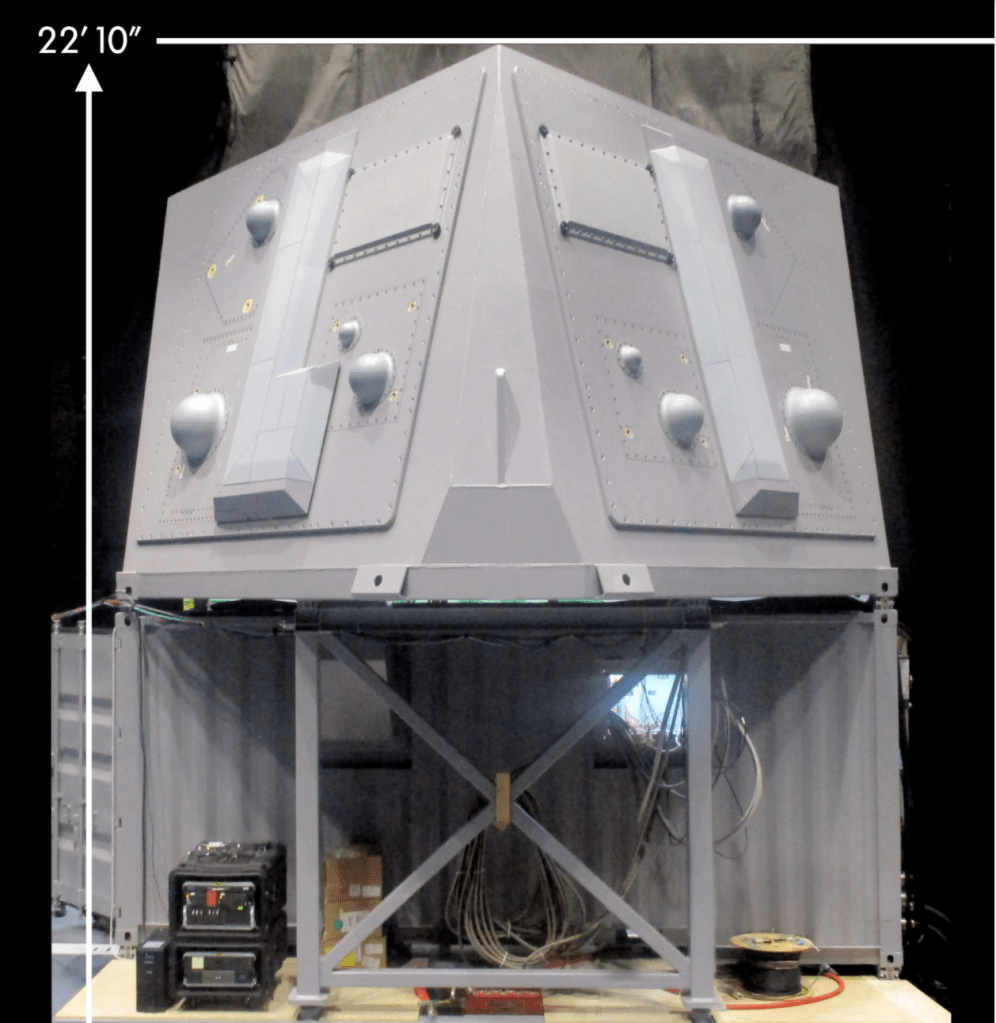
Nobody’s saying much about the true capabilities of these new arrays, but it’s safe to assume that if they can counter incoming cruise missile threats by attacking and even disabling their electronics, they can do a number on drones as well. They might just provide the sort of capability familiar to viewers of the science fiction film The Matrix, in which autonomous robotic hunter-killers, nicknamed “squiddies”, were neutralized en masse by massive bursts of electro-magnetic energy emitted at the touch of a button.
Let’s hope so, because unfortunately, swarming won’t be the exclusive province of quad-copters and other such machines. Cruise missiles will swarm too. As discussed, the new LRASM is thought to have the capability to cooperate autonomously in packs, and this isn’t really novel – a level of coordination between attacking missiles was a feature of the Soviet SSN-19 “Shipwreck” almost 30 years ago. In the future, supersonic attackers won’t just stream in one after another, they’ll talk among themselves and scheme to attack simultaneously from varying altitudes and all points of the compass, making sure to divvy up the targets to avoid ganging up on some vessels while ignoring others. Some may deliberately make themselves obvious on the way in, distracting the defenders, while others approach more stealthily, unnoticed amid all the commotion. The smarter they get, the harder it will be to spoof them with chaff and false targets. They may not arrive in groups of five or ten, but in large packs of cheap and cheerful weapons that can be lost by the dozen without blunting the attack. DARPA, diabolical is ever, is already funding development along these lines, initially with aim of overwhelming potent integrated air defence systems on land. A project for the Air Force dubbed “Gray Wolf” was a first effort along these lines:

Gray Wolf was at one point apparently abandoned, but its program goals are being assiduously pursued with a program dubbed “Gremlins”, which as at January 2020 had begun airborne testing. Unmanned gremlin drones will not only be air-launchable, but air-recoverable, returning from their missions to rendezvous with transport aircraft equipped to capture and then winch them in. While out on their missions, the aim is to have to Gremlins operate in cooperative groups, almost wholly autonomously, and provide a host of reconnaissance and defence suppression capabilities. Here’s one of the prototypes:

Two Can Play That Game, Swabbo
Anything we can do, they can do better – or just as well, anyway. We may revel in the sheer geeky sophistication of our latest weapons, but it’s all fun and games until the adversary can deploy something just as nasty. Perhaps the best example from the modern era is provided by nuclear weapons, over which America had a short-lived monopoly after 1945. That was a happy national security environment. It lasted until 1949, and we’ve been struggling to prevent entry into the “nuclear club” ever since, with decidedly mixed success. Today’s biggest nightmare is not international terrorism, but the growing nuclear arsenal of North Korea, whose development of what seem to be perfectly serviceable intercontinental ballistic missiles has come as a profound shock. Our reaction to this has perhaps been a little naive. Yes, they’re backward over there in the Hermit Kingdom, though they may be getting help (from Iran? A former Soviet republic?), but what seems to have eluded us is the ugly truth that they only have to match the technology developed in the United States by 1962 to deploy something as ferocious as a Minuteman III ICBM, or for that matter, a Polaris submarine launched ballistic missile. They were bound to get there at some point.
Other examples abound. Armed drones like Predator used to be an American specialty, but now everybody’s got them. Chuck Yeager may have been the first to break the sound barrier in 1947, but America’s first operational supersonic fighter, the F-100 Super Sabre, was matched almost immediately by the Soviet MiG-19. Prior to that, our highly advanced swept wing F-86 jets had to be rushed over to fight highly similar MiG-15 fighters that were already in action over Korea.
At sea today we see the Chinese, perhaps bolstered by their massive cyber espionage campaign, deploying their own version of Aegis, large aircraft carriers, cruisers loaded up with VLS cells, and so on. Now they may have a rail gun. Hypersonic cruise missiles are bad enough, but how do you even begin to defend against the rounds that might be incoming from enemy rail guns? The more terrifying our own weapons become, the more terrifying are the threats, and stealing a technological march on the potential foe, always a cornerstone of American military strategy (as with the current overarching “Third Offset” strategy), may actually be close to impossible these days, as perhaps it always has been (despite the occasional exception, such as the implementation of stealth technology in aircraft, a leap which it has taken the Russians and Chinese almost three decades to match).
Our new weapons are indeed awesome. What if the enemy has, or soon will have, everything we rattle at them? This seems actually to be the case. There’s a resulting risk that in an all out peer-to-peer conflict, naval forces will have reached the point at which entire fleets destroy each other wholesale within hours of the first shots being fired, as they fling weapons back and forth that neither has the means to counter. This won’t end the utility of sea power, particularly in securing the sea lanes against threats from less powerful actors, whether that’s Iran, or pirates out of Somalia, but it does make a hash of the idea of leveraging sea control in a major conflict. Naval strategy may come to resemble nuclear deterrence, with opposing fleets facing off under banners that read “Do that and I’ll kill us both”.
Soo…
It’s very much a mixed bag at present. Technologically, it’s getting to look a lot like a fevered vision of a terrifying future out there. Progress, some would say diabolical progress, is being made at rates faster than anyone would have believed. Lasers? Rail guns? Hypersonics? Remorseless, soulless hunter-killer robots, some operating on their own initiative? Drone swarms? Even as our own ships evolve to become more powerful, more versatile, and more fearsomely armed, so too does the raw power and effectiveness of the weapons designed to send them to the bottom. Are we at a crossroads? Will the first half of the new century see conventional naval forces become too vulnerable to be viable in major conflict? Or will new defensive technologies rise to the challenge, as they have in the past – the writer is old enough to remember commentary in the late 1970s and early 1980s that bemoaned the demise of the aircraft carrier, and described the massive units of the Nimitz class as “missile magnets” that had their uses in peacetime power projection missions against small and ill-equipped nations, but wouldn’t stand a chance in an all-out fight with an adversary as formidable as the Soviets. Concerns were overblown, then. Are they now?
If conventional surface fleets centred on carrier battle groups remain viable, in principle, will they in practice? Can the money and will be found to maintain the necessary force levels, at the necessary level of technological sophistication?
If not, what then?
A Modest Proposal

USS Newport News – CSGN-1
Length: 1,135 feet
Beam: 140 feet
Draught: 34 feet
Displacement: > 80,000 tons, full load
Armament: 1 x 155mm. AGS
30 x Mk.41 VLS (64 cells each) for 1,920 cells
4 x 32 Mk.41 VLS (128 cells) for 200 ESSM (quad packed) and 78 Naval Strike Missiles
4 x 5” Mk.45 62 Calibre guns
2 x Phalanx CIWS
2 x SeaRAM CIWS
2 x Directed Energy (Laser)
Aviation: 1 Hangar (forward) for Lamps III / OV-22, approx. 275,000 cu. ft.
1 Hangar (aft) for drone / AH-1 operations, approx 210,000 cu. ft.
Description: Notional nuclear powered “Strike Cruiser”
The design envisions 128 dedicated cells, 50 to hold 200 ESSM rounds, and 78 dedicated cells for Naval Strike Missiles. The remaining 1,920 VLS cells to be split between SM-2, SM-3, SM-6, VLA, LRASM and BGM-109 missiles.
CSGN-1 is meant to serve either as an alternative, or a supplement, to a Ford class carrier as the centre of a surface action group. While at first blush the vessel seems too large, and too expensive, to be viable, it would likely cost less than CVN-78, which at present estimates is costing about 14 Billion USD, plus approx. 5 billion USD for the air wing. Operating costs would also be significantly lower than a CVN; its missiles do not conduct constant ops, and its crew requirement would be much smaller.
The design has a lineage going back as far as concepts developed during the early 1980s, when the CG-47 class was new, and proposals for nuclear powered Aegis vessels, including a 16,000 ton strike cruiser, were being seriously considered. One of the most intriguing concepts to emerge in this period was the Arsenal Ship, a vessel composed almost entirely of Mk.41 VLS modules. This design draws heavily upon that idea, and takes it to the next level (the Arsenal ship was purely a floating magazine, lacking its own sensors). In hull form and general layout CSGN-1 is very much a gigantic DDG-51, as opposed to the more radical DDG-1000, and is not designed for stealth (though it does incorporate sloped surfaces). While originally conceived for an advanced Aegis configuration with SPY-1 radars (hence the SPS-48 and SPS-49 supplemental radars, and 8 Mk.99 illuminators), it would be equally suitable for the new AMDR radar suite, as depicted here.
The octagonal, elevated bridge structure was inspired by USS Long Beach, and is intended to give the phased arrays maximum height above the waterline. Another obvious inspiration was the Soviet battlecruiser Kirov, especially around the bow. The hull form is scaled-up DDG-51.
A vessel such as this might well operate without escort, shipping, as it does, a missile arsenal almost equivalent to the entire 22 ship Ticonderoga class, and operating significant manned and unmanned aviation assets. It would benefit, though, from ASW support, submarine escort, and air cover including AWACS support, so its optimal deployment would be within a surface action group of its own, or a CVN battle group, to which it would add devastating firepower. This is especially so given new weapons now coming on line: The LRASM, a stealthy, pack hunting ASM; dual-mode BGM-109 Tomahawks, with anti-ship capability; SM-6 with anti-ship capability; laser weapons; and potentially rail guns (not included here), or 5 inch guns firing rail gun munitions.
Mounted forward is an example of the 155mm Advanced Gun System, the same weapon that equips the DDG-1000 ships. This 60-70 mi. range gun is formidable, but might be supplanted by an even more powerful rail gun. The Mk.45 5” 62 calibre guns also provide an unexpectedly potent addition to the ship’s arsenal, owing to the new naval variant of the Army’s Excalibur round, a guided munition with a range of over 40 miles.
The radar fit is over the top, with both S and X band AESA arrays (SPY-3 and SPY-6), as well as SPQ-9, SPS-49 (planar – or it could be substituted for a Thales SMART-S) and SPS-48. Can’t have too much radar! Sonar would include an MFTA towed array, and SQS-53C. Also posited is the new hull mounted sonar developed for the ACTUV sub-hunter. The design also features azipods powered by electric propulsion (so there are no rudders), and both active and passive fin stabilization. Three tunnel-mounted bow thrusters are incorporated forward; Newport News would be capable of pivoting on her axis, much like the ocean liner Queen Mary II.
Here’s how you come up with such an over-the-top monster battlecruiser:
A little bit of this:
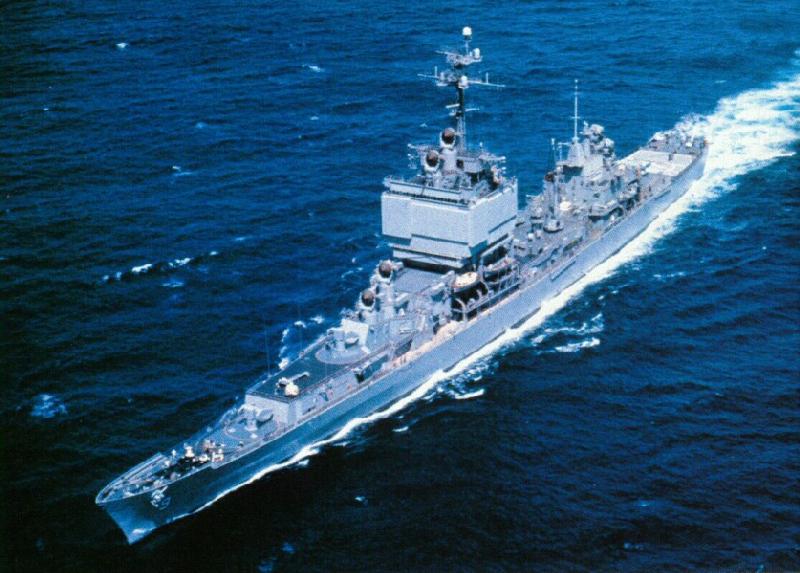
Plus a bit more than a little bit of this:

Plus a little bit of this:

Plus quite a fair bit of this:

AND a heaping helping of this:
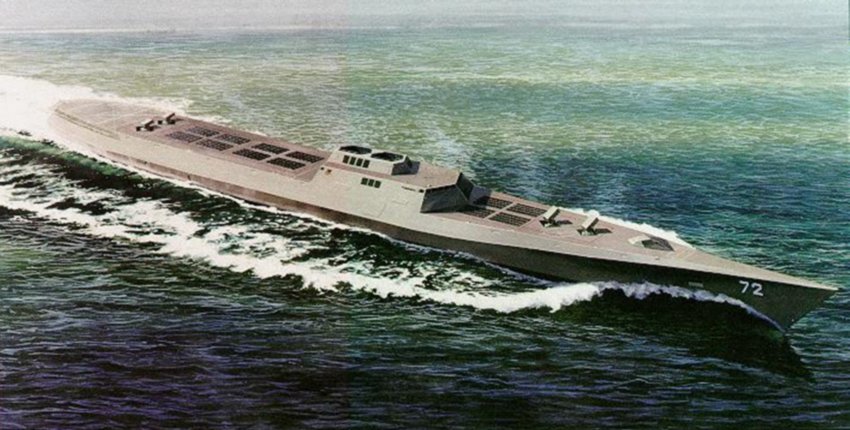
If a strike Cruiser on the scale proposed is several bridges too far, one can imagine something more modest, about Zumwalt-sized, that would still be very powerful – one such idea I cracked up:
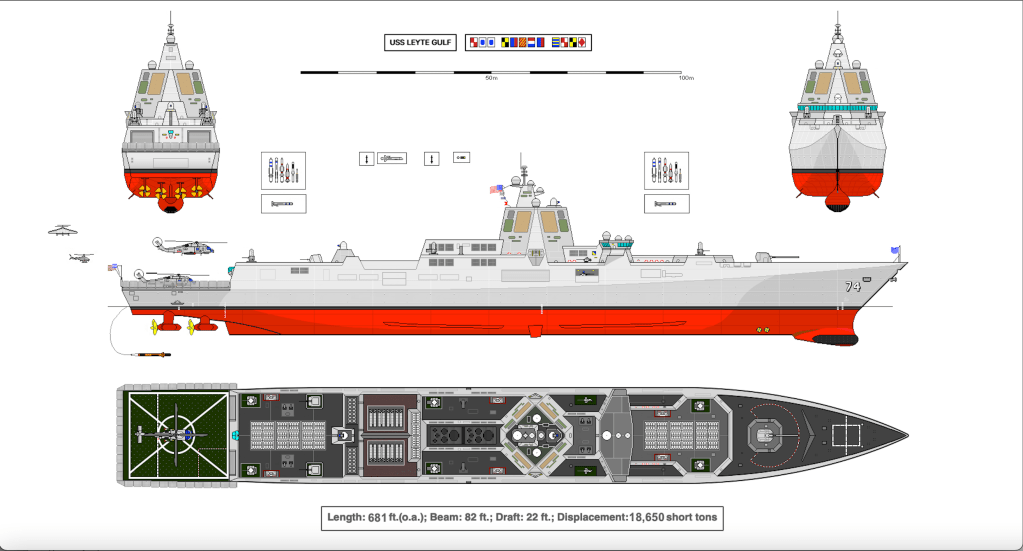
Or, you could go for something a little more in the Kirov range:
